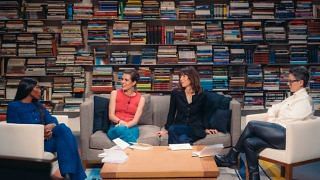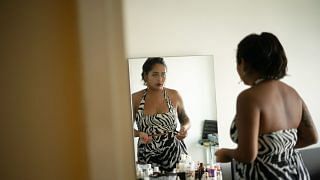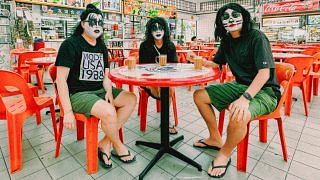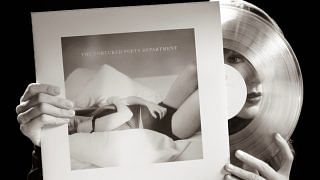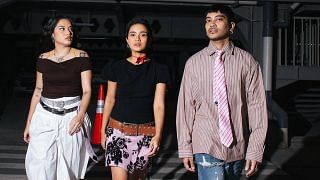It sure seems like an empowering time to be studying the arts. This August, the first government-backed private arts university here, the University of the Arts Singapore, will welcome its inaugural cohort. According to The Straits Times in a Sept 2023 report, our country will continue to invest in arts education, while the National Arts Council’s latest Population Survey on the Arts showed consistent growth in interest in the arts and at least two-thirds of Singaporeans recognising the benefits of arts and culture on the community. Ultimately though, pursuing the arts as an academic discipline remains niche (according to the Ministry of Culture, Community and Youth’s Singapore Cultural Statistics study in 2022, full-time enrolment in tertiary arts courses have been dipping year-on-year between 2016 and 2021). Here, seven youths share their intentions, aspirations and lessons learnt in having embarked on this path less chosen.
HEE KER RU, 19, YEAR-ONE STUDENT IN LASALLE COLLEGE OF THE ARTS’ BA (HONS) FINE ARTS PROGRAMME

Fine arts student Hee Ker Ru
Tell us more about your interest in art: When did it start and how was it fostered?
“I didn’t quite get into art until the later years of primary school when I started wool sculpting to combat the horrors of the then-steadily looming PSLE. I didn’t apply to the School of the Arts because I had a love-hate relationship with art: I didn’t consider myself good enough as an artist and would constantly abandon it in bouts of pubescent rage. However, I found that I was constantly drawn back to it the same way a ship is bound to its anchor.”
What made you decide to pursue fine arts academically?
“In junior college, I took GP (General Paper), literature, geography, art and maths. I knew I wouldn’t be heading towards the science stream anytime soon. It’s been easy to study any of the humanities because I have a deep love for this kind of stuff, but only art makes me feel so alive.”
Tell us more about your chosen fine arts discipline and what led you to it?
“I don’t limit myself to any discipline. I’ve always loved to stick my fingers into every medium. However, my preference is for tactile things. I like to use my hands, which is good for things like ceramics and sculpture. I have a special place in my heart for ceramic works… it’s a medium that vexes and fascinates endlessly.”

At this moment in her practice, Hee’s known for her ultra-colourful artworks that seem to reflect her spirited personality.
Are your parents and loved ones supportive of your choice to study fine arts, and does this matter to you?
“I’m in art school because I won a bet with my mother – what more can I say? I think at this point they’ve realised that they can’t stop me from pursuing the arts. Their response is not the most enthusiastic, but it’ll do. The pressure to keep doing well and to maintain my scholarship is definitely on (she is a recipient of the Lasalle Future Leader scholarship), but it’s nothing I can’t handle.”
What are the most common responses you get when you tell others that you study fine arts?
“The first response from the general public is that expression of masking bewilderment and mild disgust behind a facade of pleasantry. I find it funny to watch as people scramble to figure out the academic route that I had taken prior. Often they assume I must have come from polytechnic so when they find out I was in junior college, they then assume I had dropped out. When they realise that I had in fact graduated with good grades, the response tends to switch to one of utter confusion and pity – that I’ve ‘downgraded’ my future (by enrolling into art school). The fault in our highly utilitarian society is that many Singaporeans disparage the arts. I can balance both views, but I’m more on the pro-art side and have gotten so used to the response that I hardly bother challenging it these days. I just say that I’m pursuing my dreams, and how many people actually get to chase what they love?”

Hee is of the opinion that many Singaporeans still think the arts isn’t a path worth taking up, but that hasn’t stopped her from pursuing it.
What school were you in before this and did you also study art then?
“I graduated from Raffles Institution prior to coming to Lasalle! I took H2 Art. In a very funny and ironic twist of fate, I got 5 As and 1 B for my A Levels, and that B was for art.”
What’s the biggest misconception about arts students?
“That we’re all rich young kids with nothing better to do. This nepo baby stereotype isn’t entirely false, but most of us have worked tooth and nail to be here.”
What’s the toughest thing about your current academic programme?
“My commute to Lasalle takes one hour and thirty minutes since I stay in the far north. Having to make the literal cross-country trip to come down to the studio just to make small amendments or run little errands for my work is endlessly annoying, and also very taxing on my MRT card.”
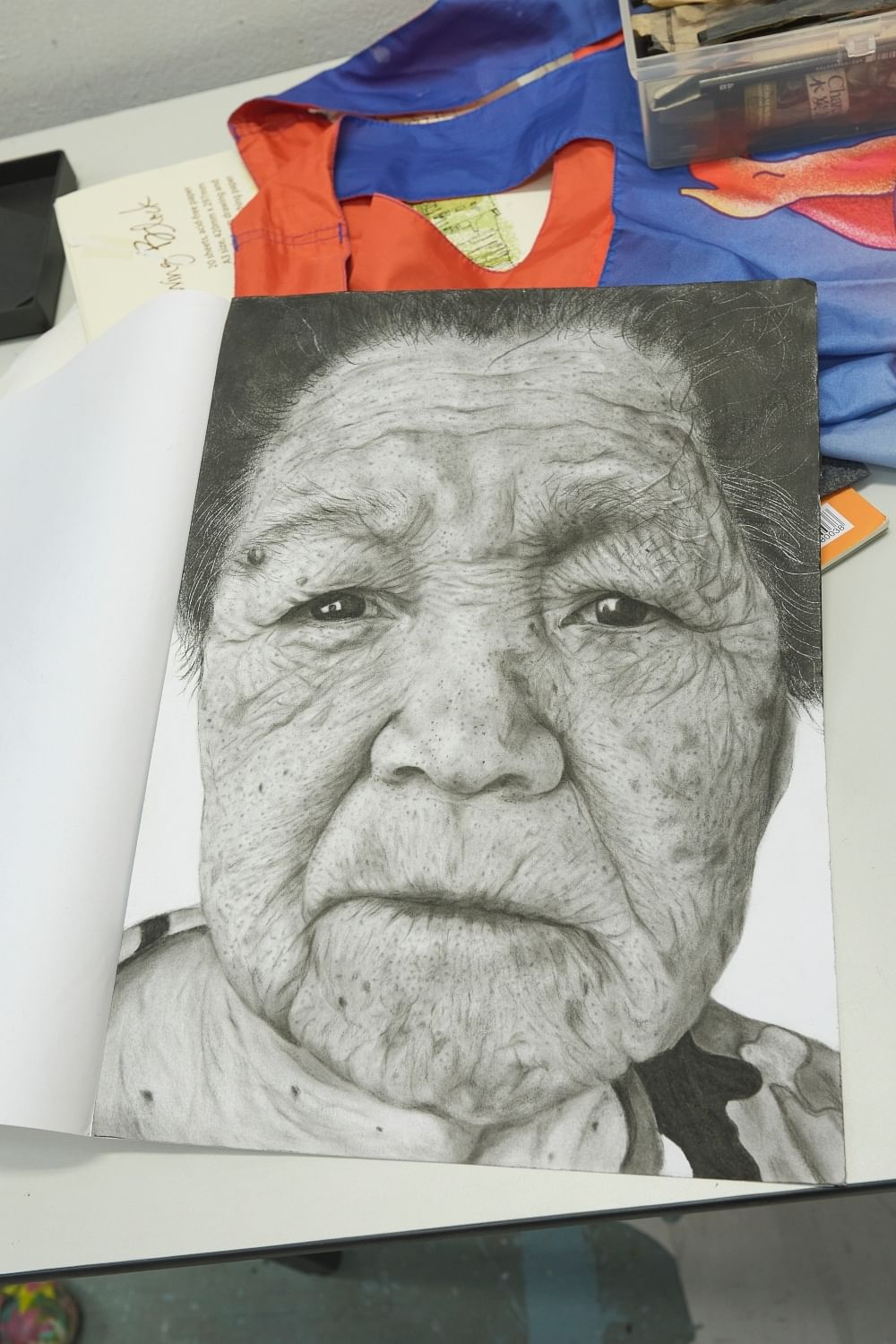
A portrait of Hee’s grandmother.
And what do you love most about it?
“The people. I am blessed to be a part of a wonderful batch filled with kind souls and amazing people. Everyone has great energy – from my classmates to the lecturers and even the management and people from other programmes.”
What would you have studied if you weren’t studying fine arts?
“I don’t think I’d be alive if I wasn’t doing art.”
What do you hope to achieve with your fine arts degree?
“The eventual goal is to be a full time artist, but I admit that is quite an idealistic dream. To avoid eating grass from the sidewalk, I am content to become a teacher or lecturer for the income while continuing my art practice simultaneously. If all else fails, I’ll photocopy my degree ten thousand times and build my own BTO (build-to-order apartment) out of it.”

To Hee, art-making in and of itself is something worth doing.
What do you hope to do after graduation?
“The aim at the moment is to work a while, and then further my studies by taking an MA (master’s degree). If my wallet and I are in the mood, I might do a PhD (doctorate) for the fun of it. I just think the title of doctor is really interesting.”
How do you feel about the art scene in Singapore and how does this impact you as an art student?
“The art scene in Singapore is honestly kind of dry. I think establishment-sanctioned art here gets wielded a lot as nice packaging that makes our country more appealing to tourists and art lovers. The truth in my books though is that artistic impulses often end up saddled with and diluted by proposals and appeals for grants. While I accept that the paperwork is a necessity, the long process starves art of the acute impulsivity that often contributes to its brilliance.”
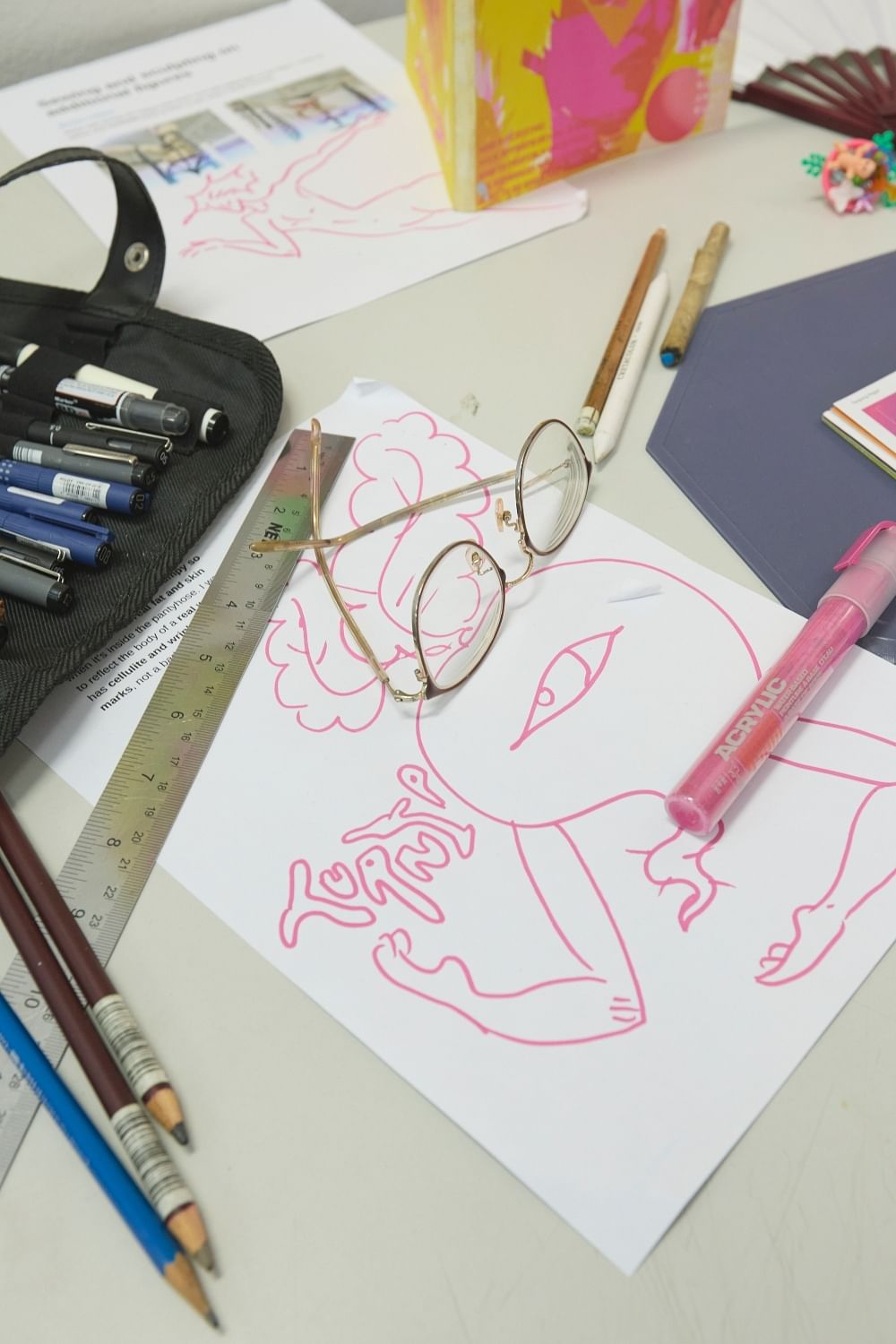
More spontaneity is needed for Singapore’s art scene to thrive, says Hee.
Do you feel your environment allows you to thrive as a fine arts student/creative talent?
“The arts scene here is quite small, which makes it both intimately cosy and a little stifling in the sense that large, global opportunities are harder to come by. Within Lasalle though, I am definitely thriving. For the first time in my life I have free time and I relish it greatly. The amount of artistic freedom accorded to me has been quite unparalleled and I’m definitely taking advantage of this.”
What do you think is needed to allow you to grow as a fine arts student?
“Money! I feel that in order to create, some sort of destruction has to take place. I feel limited when I have to cling tightly to the resources I have because they are so expensive and I refuse to waste them. In a way, this limits my experimentation with certain pricey mediums such as ceramic glazes and oil paints, but it also forces me to think out-of-the box to find cost-friendly alternatives and unconventional supplies. But I do wish I could have huge piles of supplies to fully exercise my artistic potential.”
Describe your practice and intention as an artist
“There’s a Latin quote that my former literature teacher and I like to poke fun at: ‘ars longa, vita brevis’, which translates to art is long and life is short, and refers to how the work you make outlives you. In a way, art is my way of leaving a fragment of myself in this world. That said, I’m not creating art for the sole sake of leaving a mark. In fact, I don’t quite care for memories of me and I adore ephemeral mediums… I make art because doing so is a natural impulse. It’s not something that I do for any external gain or influence. Of course, there is the petty, capitalistic rat race to earn enough to feed oneself and your ancestors. Put that aside though and creating for the sole sake of creation is enough – a means, not an end.”
SUPASSARA HO, 21, YEAR THREE STUDENT IN LASALLE COLLEGE OF THE ARTS’ BA (HONS) FINE ARTS PROGRAMME

Fine arts student Supassara Ho
Tell us more about your interest in art: When did it start and how was it fostered?
“As a kid, I liked to read novels and comics, and also liked drawing so I was interested in stories and story-telling through art from a young age. At the same time, I didn’t do so well in school or in tuition courses. My parents noticed that I liked drawing and painting, so they sent me to study these art forms outside of school. They even sent me for lessons in cooking and music as a backup. I think my interest in the arts grew from there.”
What made you decide to pursue fine arts academically?
“I wanted to explore methods of storytelling and self-expression through different mediums, and to learn more about the theoretical part of art and the contemporary scene.”
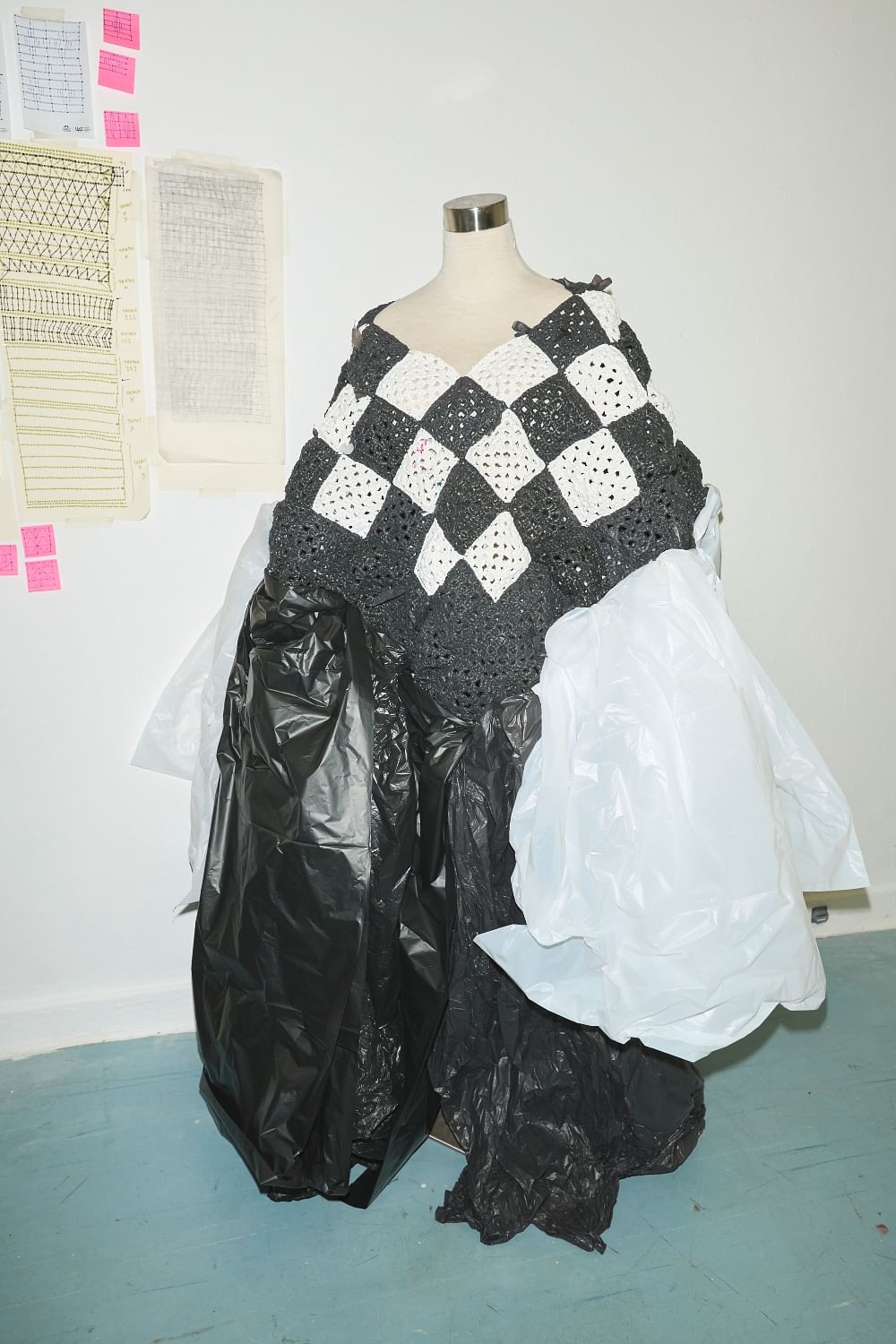
Ho, a Thai native, comes from a family background that specialises heavily in hands-on crafts such as scrap recycling, shoe-making, sewing and tailoring, and she believes in expressing herself through art and craftsmanship.
What led you to your chosen art medium?
“In my first year at Lasalle, we got to learn about many mediums such as painting, drawing, printmaking, figure drawing, sculpting and coding. It was like a foundation year for me as I gained many technical skills for making art. However, before enrolling into Lasalle, I had already picked up crocheting as a pastime during the pandemic and eventually learned to crochet using plastic bags in my first year at Lasalle, presenting it as a form of sculpture for assessment. I’ve since focused more on crochet and other related crafts.”
Describe your practice and intention as an artist
“At its core, my practice is about my roots and my family, and how craft and the love of making is passed down from one generation to another. Both my mother and father came from humble families who worked with very hands-on crafts such as shoe-making, sewing and tailoring. Now, in the current generation, we are recycling scrap metals by melting them back into bars as manufacturing materials. My practice is a way for me to slow down and enjoy the process of making. I want to express that there is self-love in the process of labour, whether you’re making something for others or for yourself.”
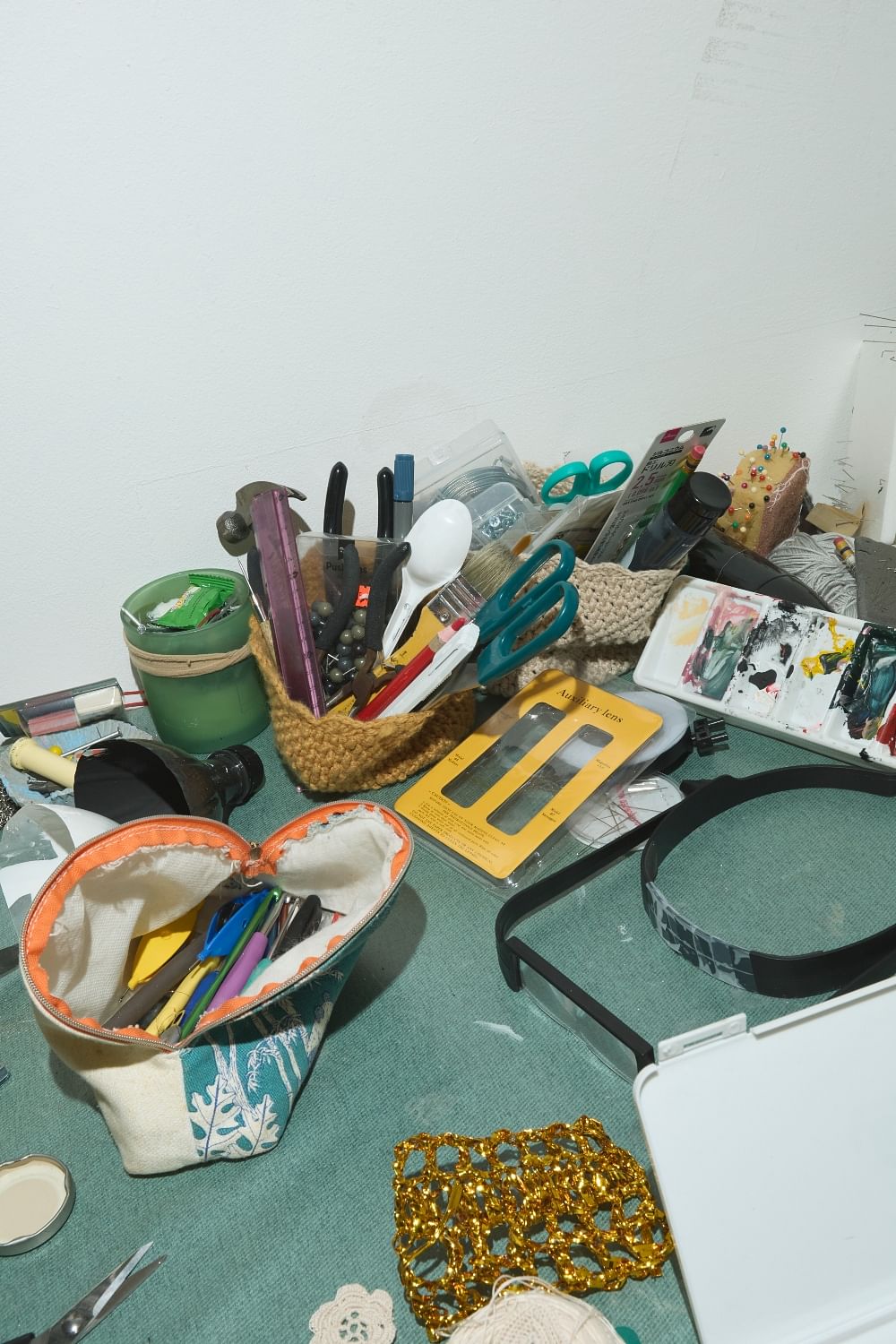
A look at Ho’s work table.
Are your parents and loved ones supportive of your choice to study fine arts, and does this matter to you?
“My parents are supportive of my choice to study fine arts and, in return, I have promised to help out with the family’s recycling metals business after I graduate. When they were my age, my parents always wanted to pursue arts, but their parents didn’t allow them to because of the lack of money as well as misconceptions about studying art among the older generation. So when I told them I wanted to study fine arts, they understood and supported my decision. I feel very lucky and grateful to be born to parents who try to give me what they never got growing up.”
What are the most common responses you get when you tell others that you study fine arts?
“Most assume that I would be able to do big clay sculptures or realistic painting really well. I can paint and sculpt, but I wouldn’t call myself a painter or a sculptor.”
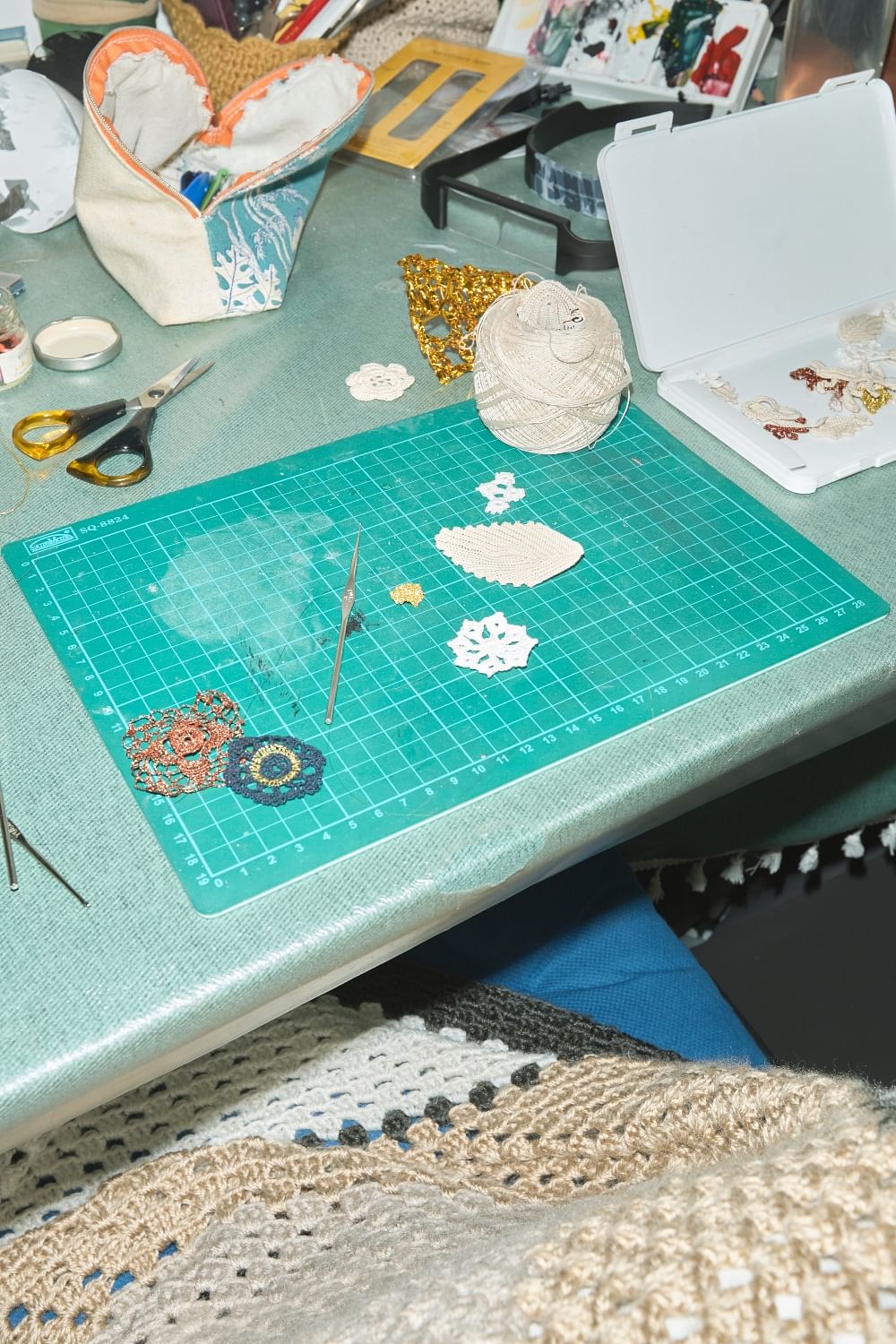
Ho’s smaller experiments with yarn.
What school were you in before this and did you also study art then?
“Before Lasalle, I was a high school student at the Saint Francis Xavier school in Thailand and didn’t really have a formal art education. My high school didn’t have a separate course for art, but I did get to learn art as an extracurricular subject and through additional classes outside of school. I also practised drawing at home.”
Biggest misconception about fine arts students?
“That we are all good at art. I cannot speak for others, but if I was already good at doing art, I wouldn’t be here.”
What’s the toughest thing about your current academic programme?
“Having self-discipline. I think as an art student, I sometimes rely too much on making the work only when inspiration hits. To counter this problem, it helps to become a better listener, to ask more and read more, and to go see what other artists are making so that we get inspired. Maintaining the drive to do so can be tough though because it is so easy to get caught up working on your work at home and this often leads to burnout.”
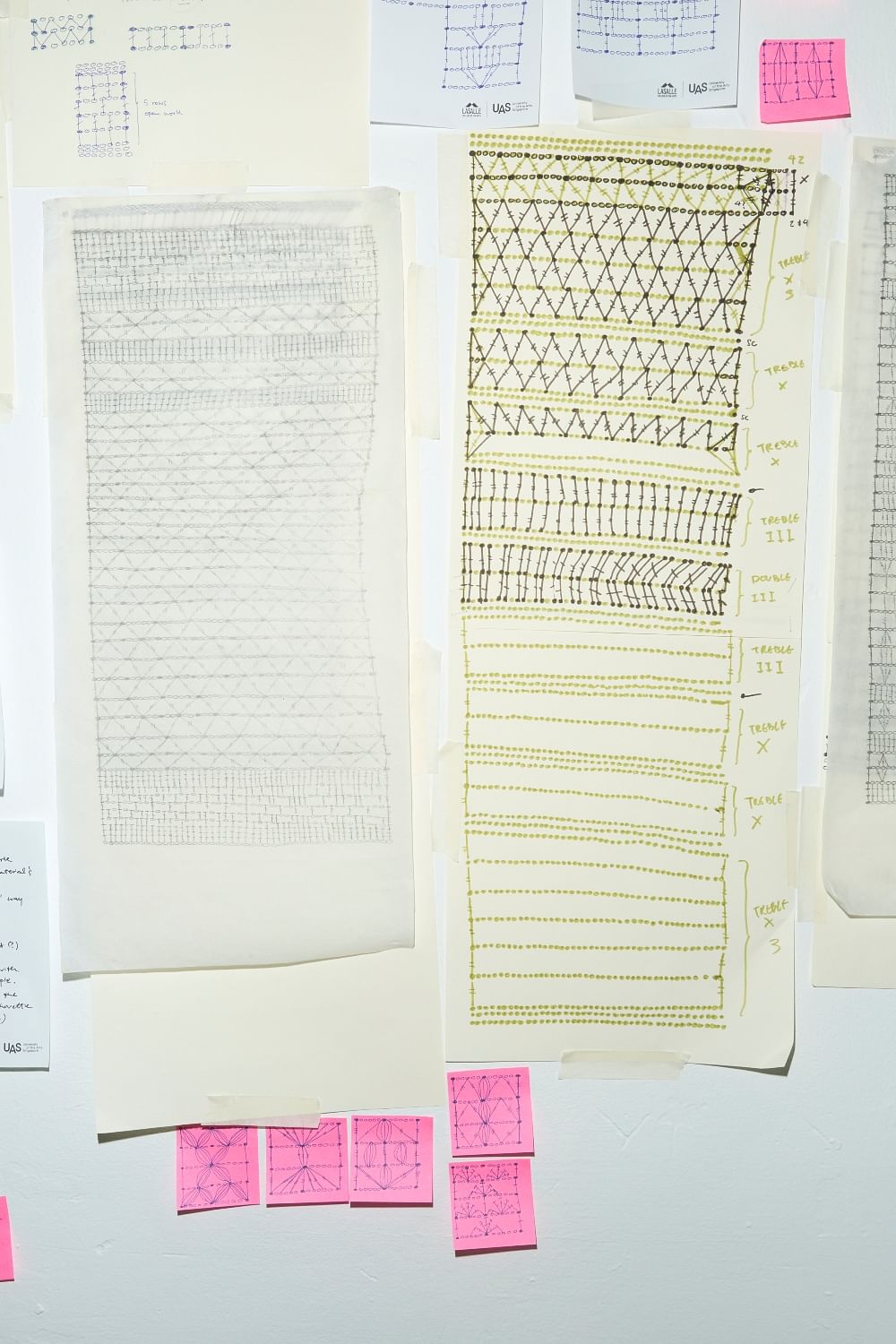
Being self-disciplined is one of the most difficult part of Ho’s journey as an emerging artist.
And what do you love most about it?
“I love that we are given studio spaces to work in, and I love seeing what my classmates’ spaces look like, especially during assessment week because I get to see so many beautiful and interesting works. Most of all, I love getting to learn from my lecturers who are practising artists in the industry.”
What would you have studied if you weren’t studying fine arts?
“I’m sure I would still be in another arts-related programme because I love making things – and I can’t do maths.”
What do you hope to achieve with your fine arts degree?
“I hope to be able to learn how to articulate my thoughts better and use what I learn from this degree programme to continue my own practice outside of school, as well as to help guide me through the thought process of working on other projects.”
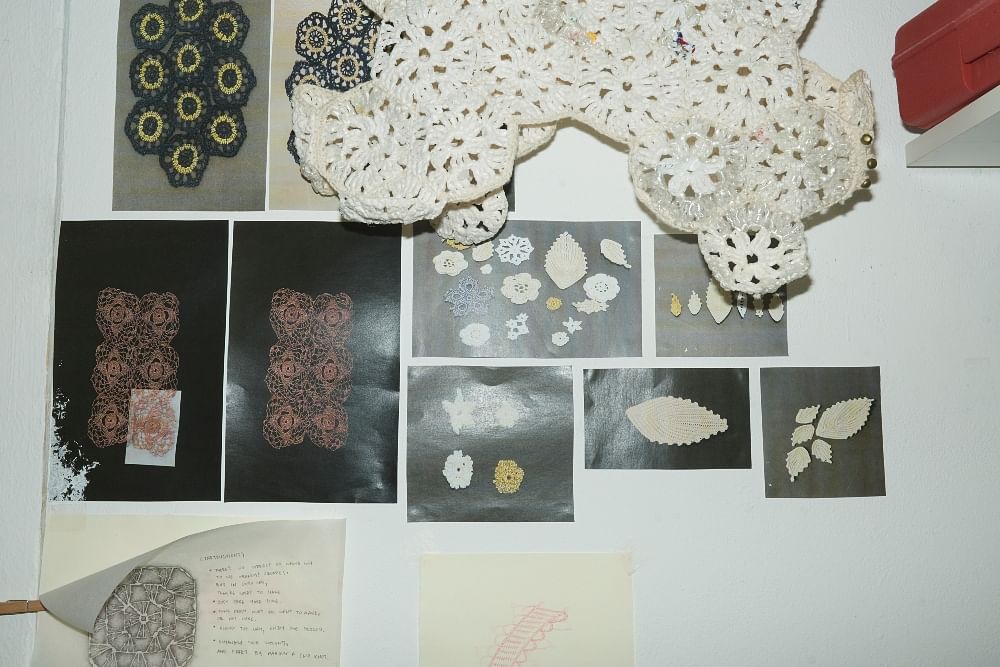
While her practice is often manually laborious, Ho says there’s an aspect of self-love to it
What do you hope to do after graduation?
“I hope to study more about crafts, textiles, writing, and art in general. In this life, I would like to become a good craftsman because I like making things. Whichever programme I do next, I hope to be able to apply what I learn from my time here.”
How do you feel about the art scene in Singapore and how does this impact you as a fine arts student?
“As a foreign student from Thailand, I feel like the art scene in Singapore is very active and diverse, and I like seeing different cultural backgrounds or stories coming through each artist’s work. And I like that the art scene in Singapore encourages art education across ages. For example, museums here have activities for children and there are always exhibitions running in both museums and galleries. As an art student, it helps me feel inspired to continue my art practice.”
Do you feel your environment allows you to thrive as a fine arts student?
“Being a foreign student, I don’t live in my own home here so I spend most of my time in school. This is why I find it very cool to be given my own studio space in school to work and experiment in and not have to worry about messing the place up. Being around other art students and lecturers who are practising artists also motivates me to create more art.”
What do you think is needed to allow you to grow as a fine arts student?
“More time and space to explore, experiment and practise with different ideas and mediums… And also, of course, more time to visit exhibitions.”
JACKIE ANG, 21, YEAR TWO STUDENT AT THE NANYANG ACADEMY OF FINE ART BA (HONS) FINE ARTS PROGRAMME

Tell us more about your interest in art: When did it start and how was it fostered?
“I’ve always been a visual person and have enjoyed creating art since I was young as I always got a sense of fulfilment from doing so.”
What made you decide to pursue fine arts academically?
“I wanted to be exposed to as many different art forms as possible.”
Tell us more about your chosen fine arts discipline and what led you to it?
“I took printmaking and drawing during my diploma – I believe that every brilliant idea comes from a sketch or a plan and wanted to exercise and improve my drawing skills. Through printmaking, I also became very attracted to creating texture in 2D mediums. I think that’s why I now lean more towards crochet/textile mediums.”
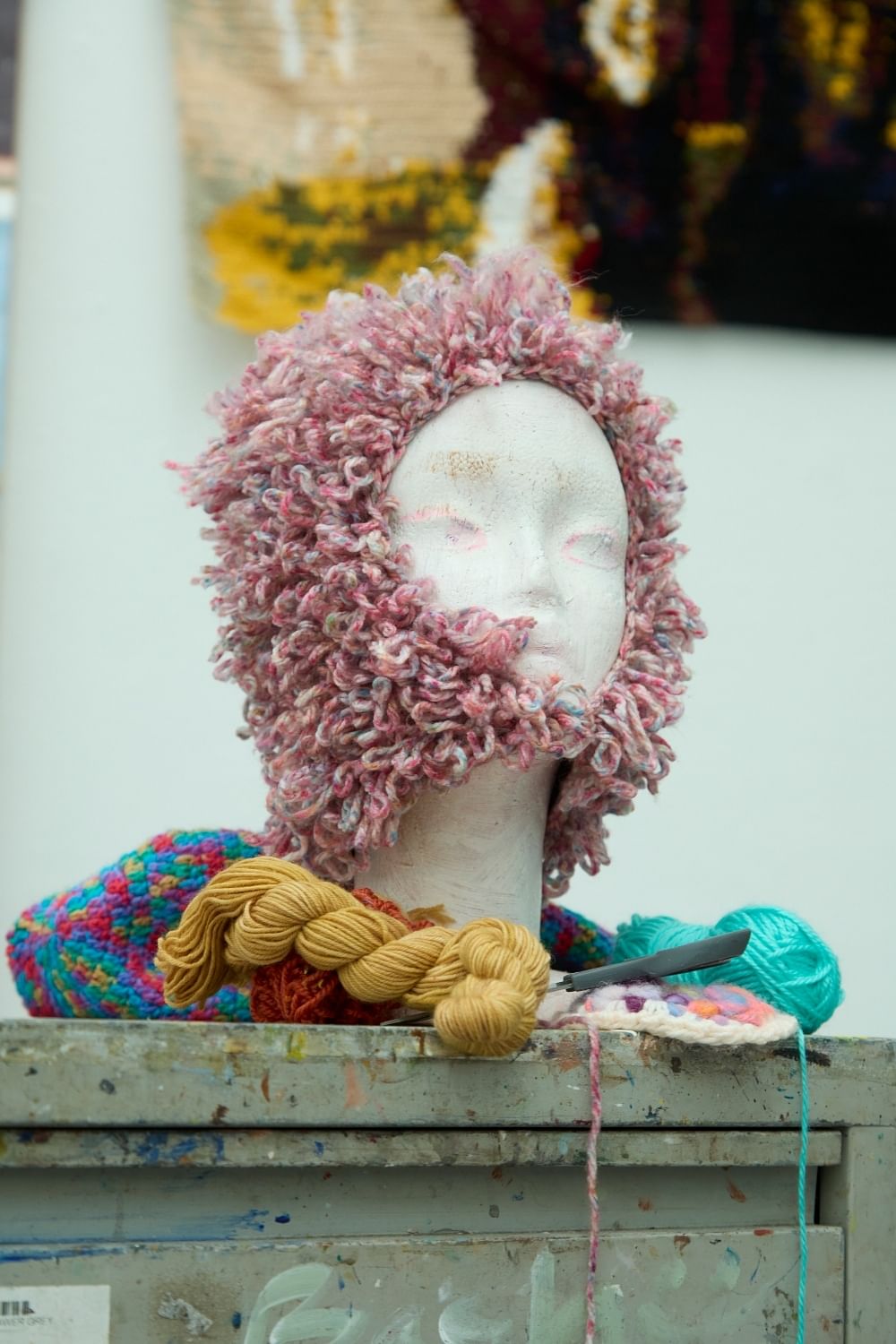
Describe your practice and intention as an artist
“To provoke narratives of norms through the idea of absurd play.”
Are your parents and loved ones supportive of your choice to study fine arts, and does this matter to you?
“At first, no – my family was struggling financially when I first applied to study at the Nanyang Academy of Fine Arts (NAFA). My parents’ main concern was being able to afford the school fees and I wouldn’t have made it without the scholarships and grants NAFA has given to me. Aside from money, my parents don’t really understand the arts in general, but they love me for being myself and support me regardless, and I really appreciate that.”
What are the most common responses you get when you tell others that you study fine arts?
“‘You all do arts and crafts?’ – I have to explain that fine arts is more than that. It dives into digital art, graphic design, photography, multimedia, performance art, installation art and a bunch of other creative fields. This variety helps students explore different mediums and stay adaptable in the ever-changing art scene.”
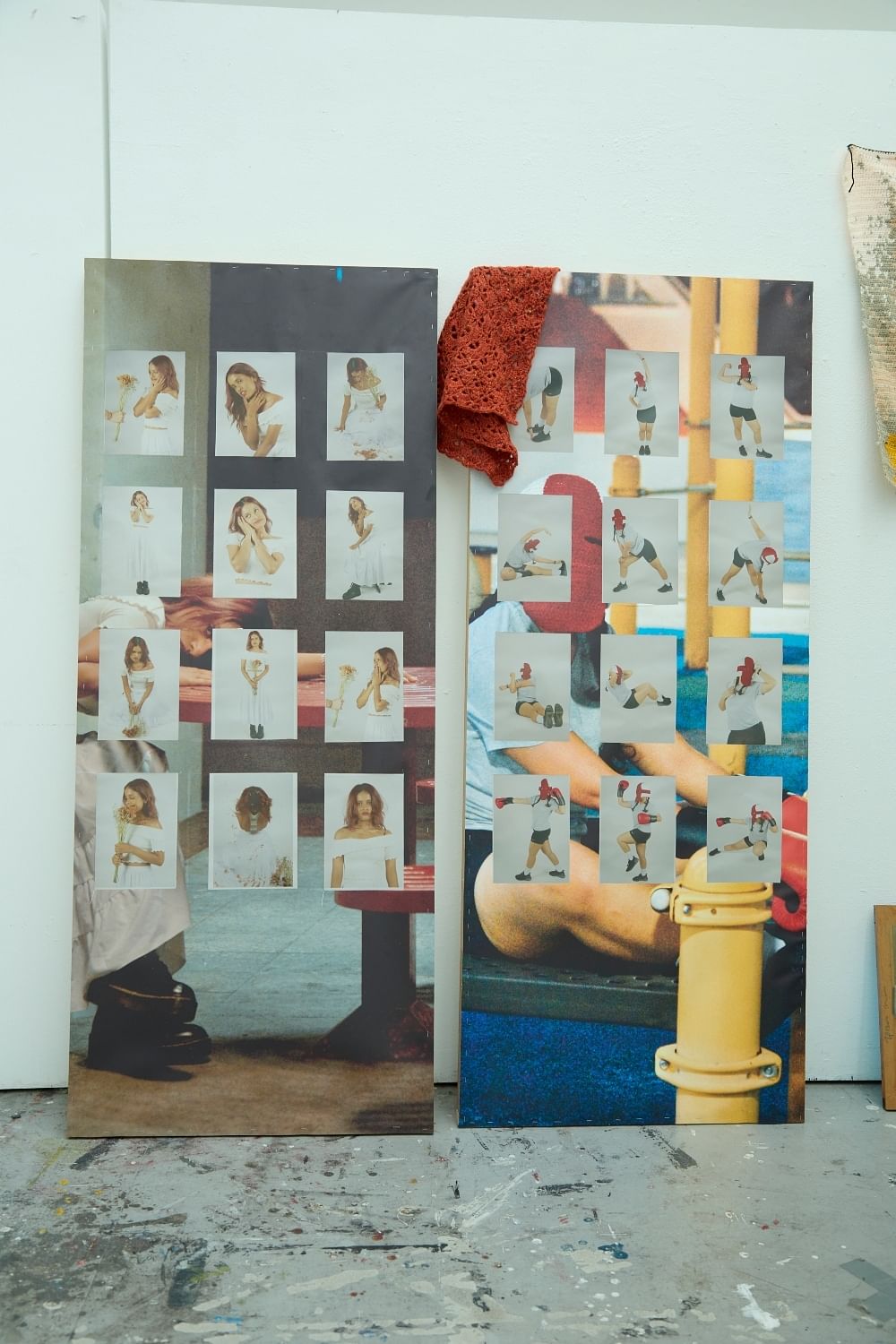
Biggest misconception about fine arts students?
“That artists are useless.”
What’s the toughest thing about your current academic programme?
“Critiquing others and taking criticism. If you can’t handle judgement, you can’t be judging others. Learn how to accept this by letting go of your own ego and taking the most enormous step back. I feel that in doing so, it makes one more empathetic.”
And what do you love most about it?
“My friends.”
What would you have studied if you weren’t studying fine arts?
“I would’ve gone to culinary school and become a chef. I was at the At-Sunrice GlobalChef Academy for a few months to learn more about the food and service industry. It was very fun, but I got lowkey bullied at the cafe I was placed at as part of the course.”
What do you hope to achieve with your fine arts degree?
“To make an impact on culture and society.”
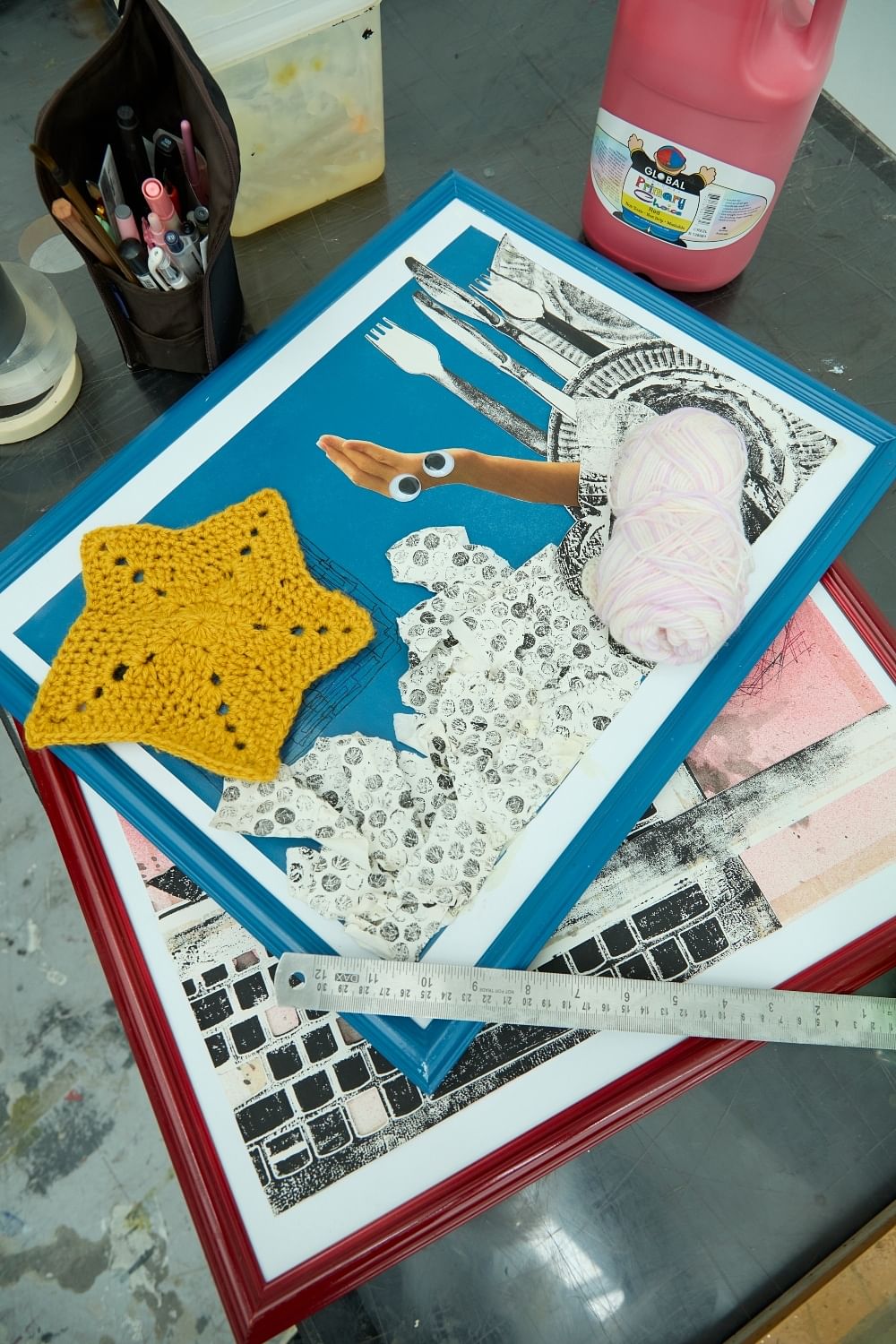
What do you hope to do after graduation?
“Residencies and fellowships”
How do you feel about the art scene in Singapore and how does this impact you as a fine arts student?
“There are more people recognising art as something important, and I think it’s so exciting to see and be a part of this growth.”
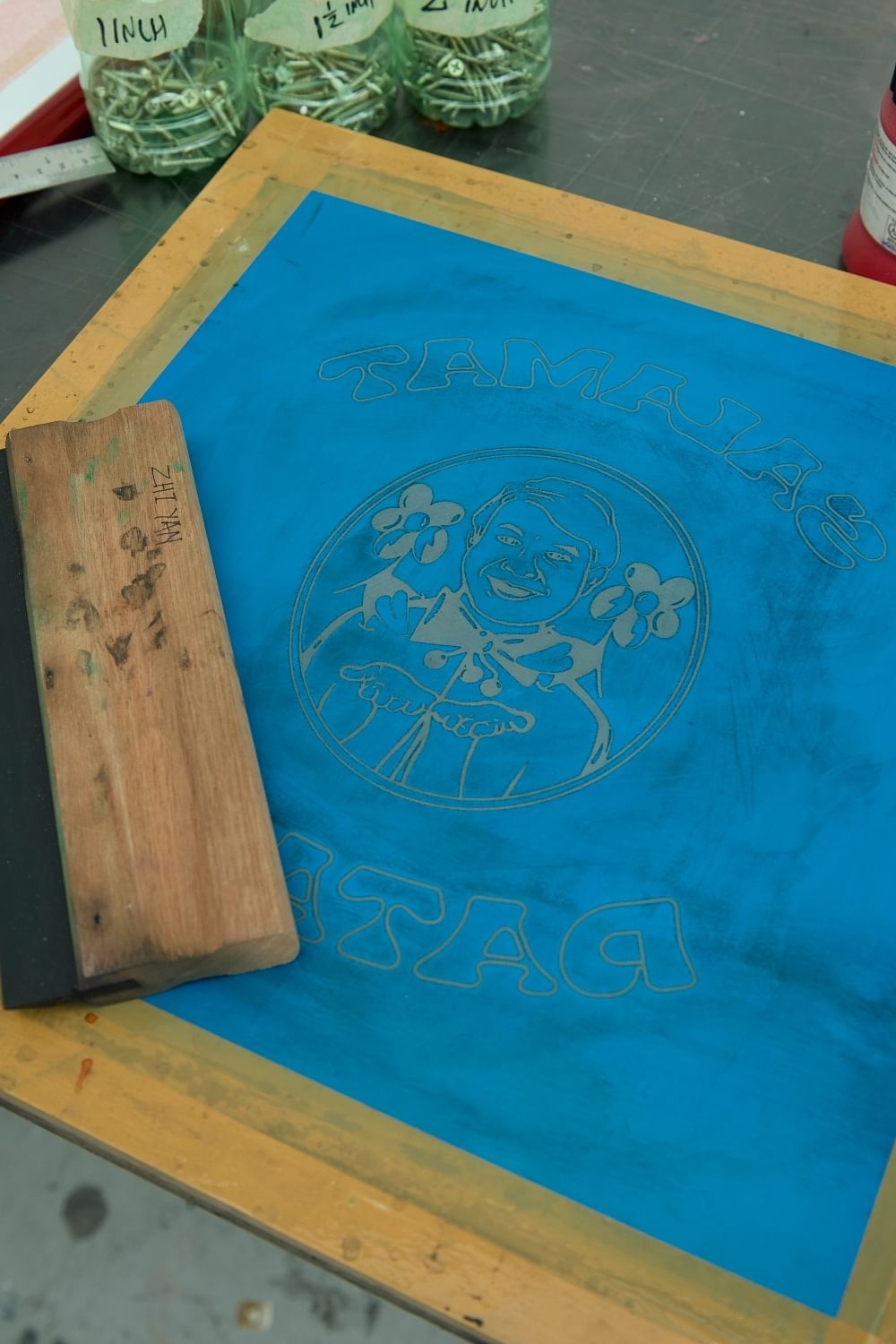
Do you feel your environment allows you to thrive as a fine arts student?
“Yes and no. Most creatives draw inspiration from talents overseas. That’s why networking and meeting new people are so important.”
What do you think is needed to allow you to grow as a fine arts student?
“More interactions with others.”
LUCAS TAN, 23, YEAR THREE STUDENT IN LASALLE COLLEGE OF THE ARTS’ BA (HONS) FINE ARTS PROGRAMME

Tell us more about your interest in art: When did it start and how was it fostered?
“My parents have told me that I’ve always liked drawing as a child. I think I watched a lot of cartoons and comics back then and remember vaguely trying to draw the cartoons that I saw on TV, but with my own storylines.”
What made you decide to pursue fine arts academically?
“Growing up, many people have been really supportive of my art and I realised that there’s probably nothing that I am better at. As a teenager, I slowly discovered my passion for many art-related things – makeup, fashion, performance – so I was already pretty set on studying art at an early stage. I had originally enrolled in Lasalle for its Diploma in Fashion programme, but realised that I made the wrong choice. I decided then that I could not see myself doing anything else long term besides fostering my relationship with the fine arts.”
Tell us more about your chosen fine arts discipline and what led you to it?
“I was doing large-scale watercolour paintings for my ‘O’ Levels and diploma programme, and would say that I have gotten pretty good at it as much as it requires a lot of patience as my methods require a lot of layering. I had chosen watercolour previously because of its accessibility and ease of bringing around. All that’s needed is a few brushes, a palette, some water and I can start painting practically anywhere. However, I started doing and enjoying doing oil paintings while serving my national service, when I had a lot of time to let the paint dry slowly. What led me to that? I guess I have always been a visual artist, and spending time painting and conveying my stories has always been a part of how I process things.”
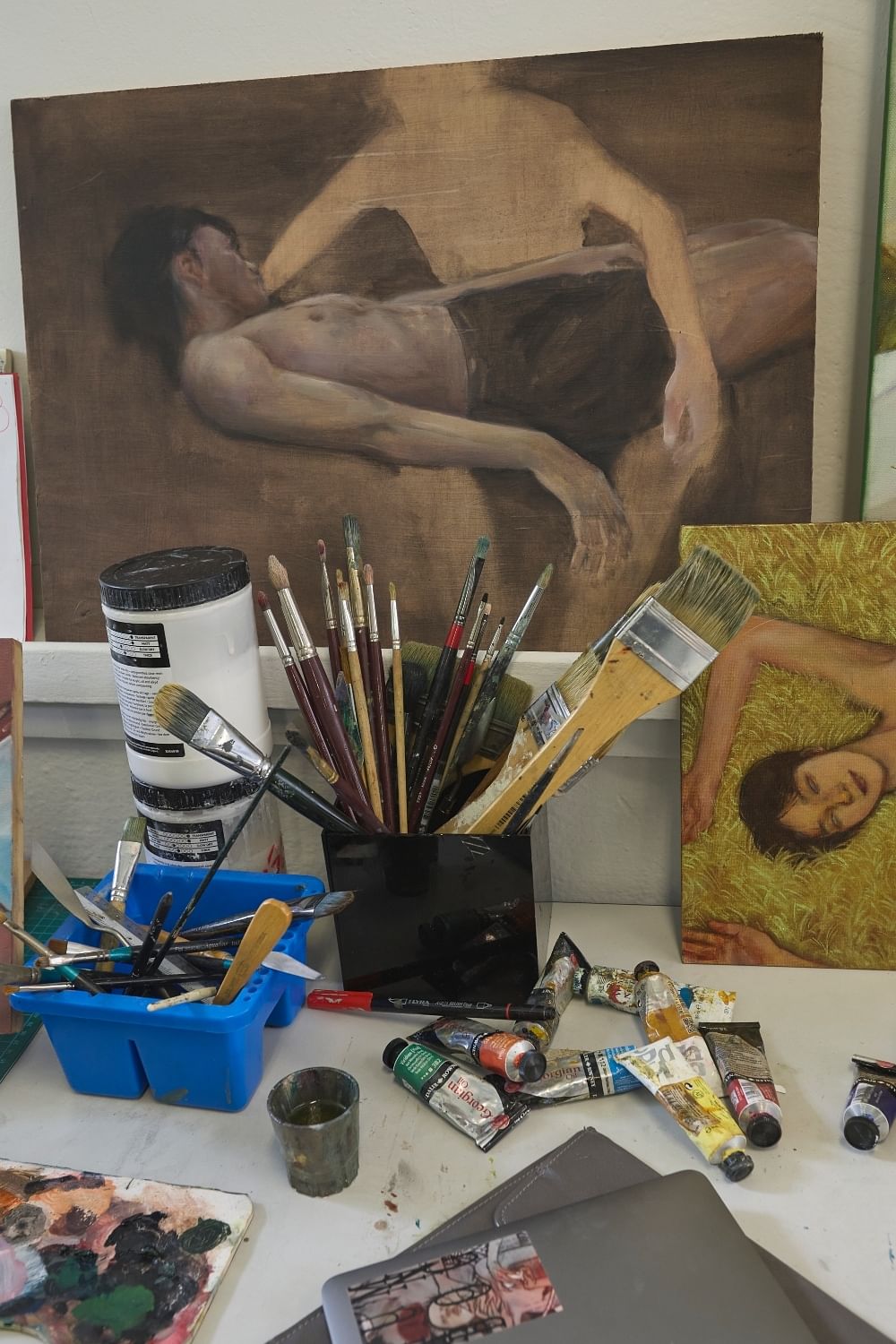
Describe your practice and intention as an artist
“My practice focuses on the notions of pleasure and desire. I typically paint individuals I personally know and find attractive, exploring themes of relationships, yearning, mourning, and grief. I occasionally delve into self-portraits too. The direction of my work often depends on my current state of emotions, reflecting a personal visual diary that captures my hopes and emotions directed both inwardly as well as toward my muses.”
Are your parents and loved ones supportive of your choice to study fine arts, and does this matter to you?
“When I was around the age of 11 or 12, my mum was pretty against me pursuing the arts in school. At that time, the movie Dolphin Tale also happened to come out. It’s about a reclusive young boy who rescues a dolphin with a broken tail, skips school to treat it at an animal hospital and finds his passion and enthusiasm for working with animals there. My mum watched it and was so moved, she cried and changed her mind. Receiving support from people around you can really aid in building your confidence. I would be lying if I said that I am not worried about my future, but with encouragement and support from both family and peers, I have become more inclined to take risks and grasp opportunities instead of forgoing the chance altogether.”
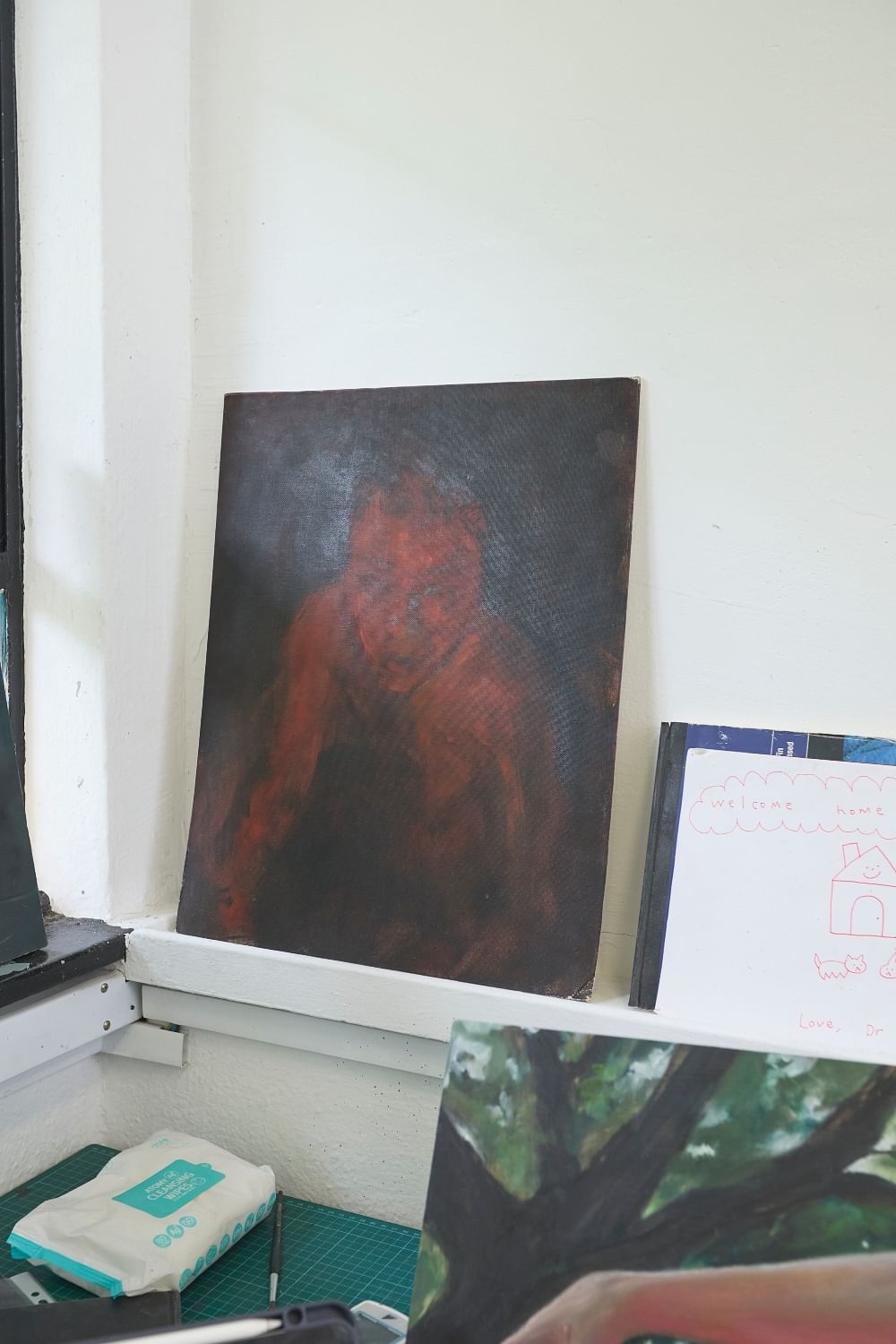
What school were you in before this and did you also study art then?
“Yes I did! I did my Diploma in Fine Arts also at Lasalle and, before that, took art as an O-level subject.”
What are the most common responses you get when you tell others that you study fine arts?
“Many would either say it’s cool to see someone pursuing their passion academically, or show concern over the financial stability of this industry. To the latter, my response has been to tell them that I do have experience outside of the fine arts. I don’t mind their opinions. I just think that standing firm on the choices that you make in life is very important and help others see how seriously you take this.”
Biggest misconception about fine arts students?
“I think many people think that we took up fine arts because we didn’t know what to do in life. The truth is that many of us – especially those who have decided to further our studies are very serious in our practice. I can tell how passionate my peers are based on my encounters with them as they discuss their works.”
What’s the toughest thing about your current academic programme?
“Writing essays and dissertations – honestly, I’m really bad at this. It’s easier for me to express myself in face-to-face conversations even if this might lack polish. Formal settings, which are a necessity in an academic setting, don’t quite align with the nature of my practice.”
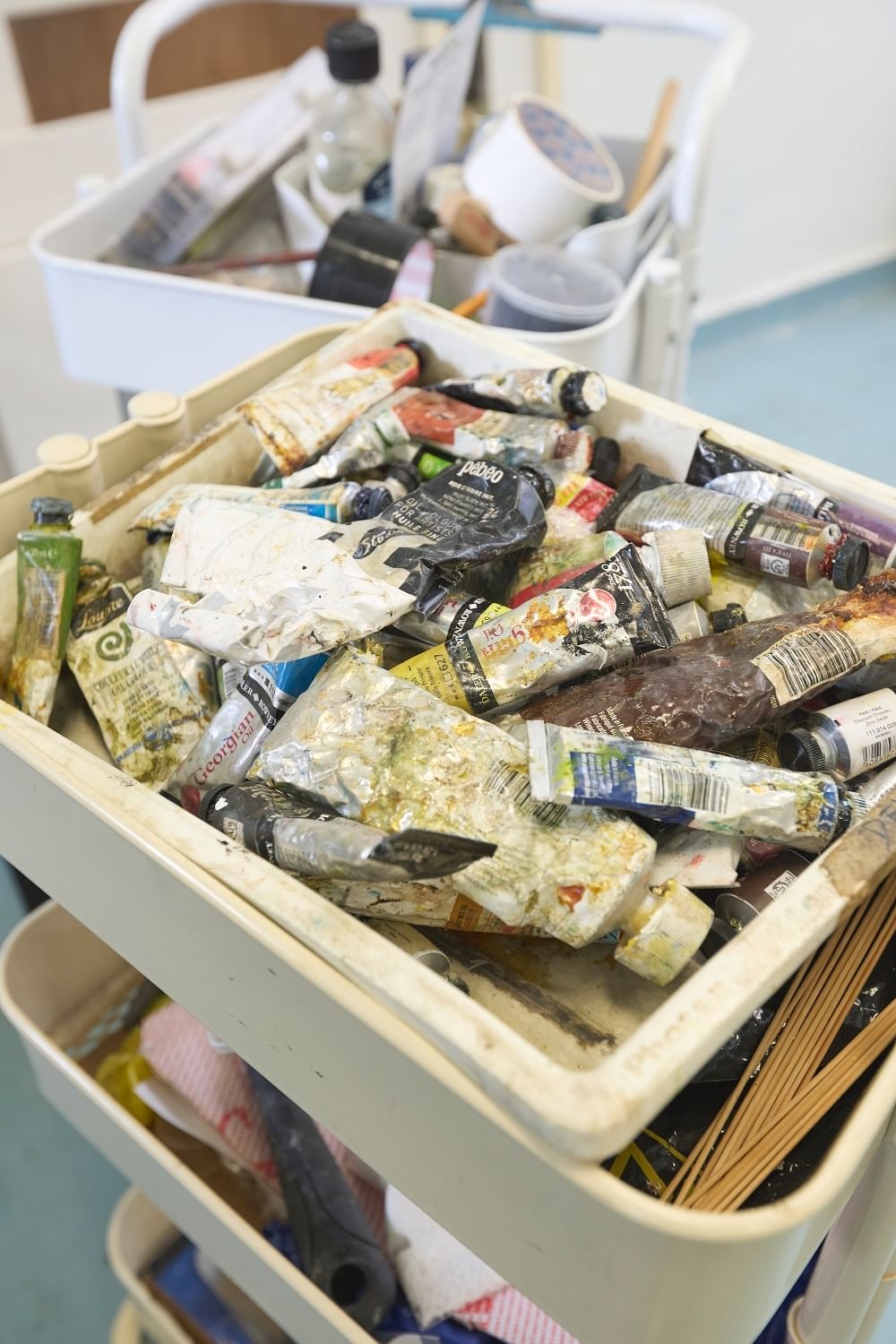
And what do you love most about it?
“My favourite aspect of studying here is the studio space that the school provides. Each of us has our own personal space to focus on our practice and it’s the highlight of my time here. Whether I am painting alone or with peers around me, it creates this really chill atmosphere. I also love spending time with friends, visiting each other’s studios, and discovering what everyone is working on. Overall, what I cherish the most is being in a creative space where people can work and create together.”
What would you have studied if you weren’t studying fine arts?
“I’m not joking when I said I’m genuinely not good at anything else beyond art-related fields. Maybe visual design or theatre? I do enjoy working behind the scenes on photo shoots too so fashion media could be another option. Just give me anything art-related and I’ll be happy.”
What do you hope to achieve with your fine arts degree?
“To become a full-fledged artist of course! And I’ll probably continue painting while making sure that I survive financially.”
What do you hope to do after graduation?
“Being a full time artist would be the dream, but I’m also pretty flexible. I have been working as a marketing associate, a gallery assistant and doing make-up freelance on the side all while also studying e-commerce and the magazines trade. So I would say that there are plenty of things in the art industry that I enjoy doing and can fall back on.”
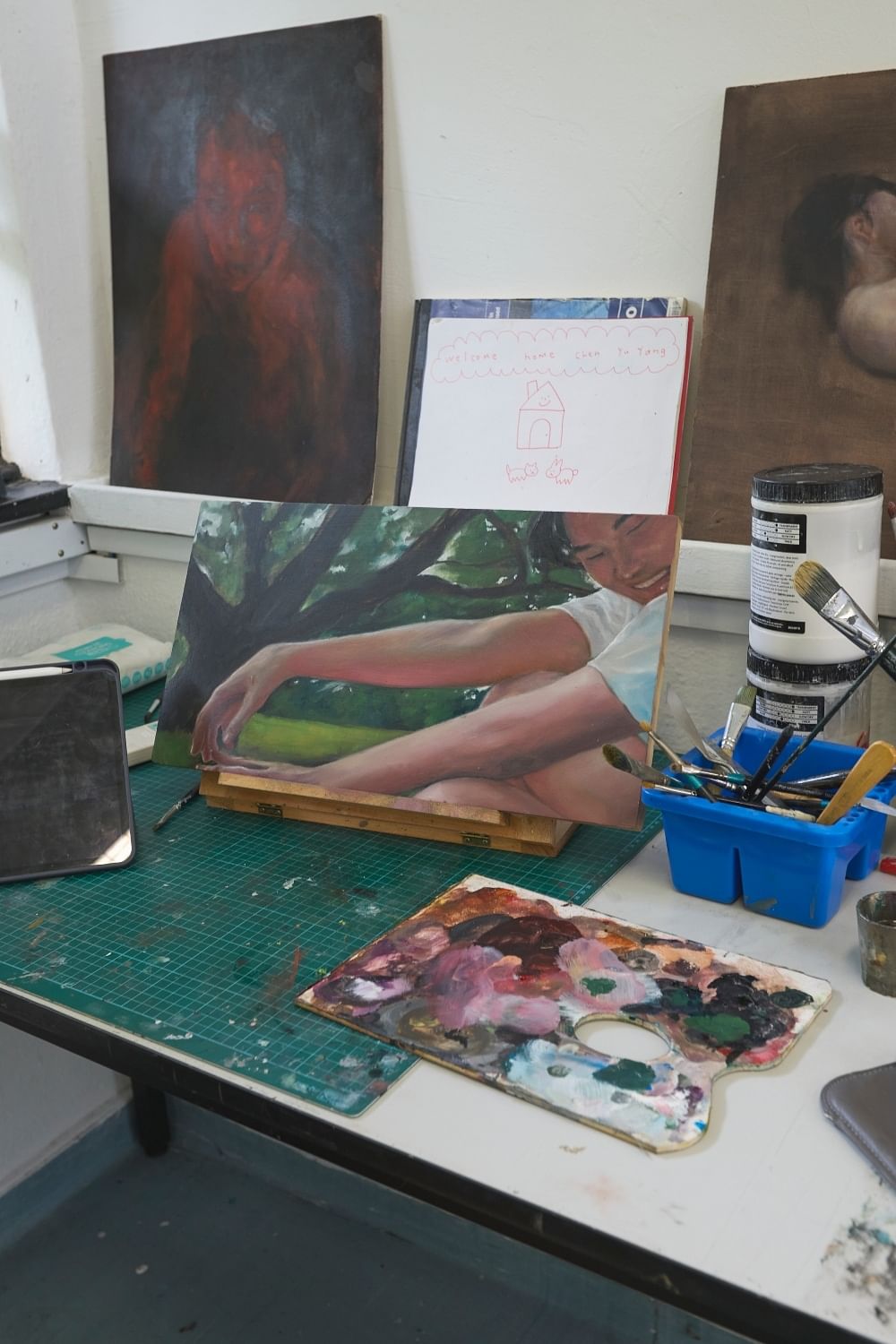
How do you feel about the art scene in Singapore and how does this impact you as a fine arts student?
“I think it’s growing and I see a lot of support coming from the older generation of artists in Singapore. In fact, many of the opportunities that I have been given came through people whom I’ve met at Lasalle. One person that I would really like to extend my gratitude to is Moses Tan, the artist and founder of independent art space Starch – he was also from Lasalle and he’s someone who has shown me so much love and support over the years.”
Do you feel your environment allows you to thrive as a fine arts student?
“Yes, my school and home environment are quite conducive for me to create works, and I have definitely seen galleries in Singapore support local painters! The arts industry scene here still isn’t as big as compared the other international markets, but I am still very hopeful about being an artist here.”
What do you think is needed to allow you to grow as a fine arts student?
“Probably more exposure and opportunities facilitated by the school? Lasalle has given me many, but more wouldn’t hurt!”
DIVYA DHASHINI, 25, YEAR TWO STUDENT AT THE NANYANG ACADEMY OF FINE ARTS’ BA (HONS) FINE ART PROGRAMME

Tell us more about your interest in art: When did it start and how was it fostered?
“Since I was in kindergarten, I’ve been doodling constantly… I’ve always loved daydreaming and creating stories and characters in my mind and drawing them out. One core memory happened in secondary school: Art was my favourite class and I remember my art teacher Miss Chong holding up one of my paintings, scanning it with her eyes and commenting that it was really nice. I do not know why that moment has been so impactful on me – it might have been a passing comment but it meant the world to me and ignited in me the desire to pursue art seriously. Before joining NAFA, art was a hobby, but my practice has evolved since I enrolled in school. I’ve begun to understand myself better as an artist and what I want to create. I am being trained to think beyond technical skills and to develop concepts and understand the various art scenes and practices in Singapore. This has really changed how I approach my art practice and made me more poetic.”
What made you decide to pursue fine arts academically?
“My experiences as a former nurse have taught me that life is short and unpredictable, and that we can’t let fear stop us from pursuing our passion. I also wanted to surround myself with like-minded people – people who were passionate about the arts – and being a self-taught artist limits how much one can improve his or her skills. Going to art school has also become a great way to build new connections and find more opportunities in the art world. When you surround yourself with like-minded people, you are more motivated to put yourself out there, explore new techniques and mediums and learn from others. It is harder to do that on your own.”

Tell us more about your chosen fine arts discipline and what led you to it?
“Sculpting is my favourite because I get to dirty my hands and play around. I am a very messy person and don’t like things to be neat and smooth. Sculpting gives me the opportunity to create works that are organically shaped and not well put-together, but still look cool. That is the beauty of building things by hand. I also love how sculpting engages most of my senses: the smell of the clay, the touch of the soil, the sight of the different textures and so on… I was introduced to the ceramic workshop here at NAFA and the moment I played around with a ball of clay, I knew this was going to be my favourite mode of expressing myself.”
Describe your practice and intention as an artist
“In my art, I aim to reveal the beauty and discomfort within living things. Combining my interests in biology and art, I work with organic patterns and anatomy to explore both the repulsive and fascinating aspects of bodies using conventional and more unconventional mediums such as wax, mud and even corn flour… My aim is to invoke visceral responses from the audience, and to create room for personal interpretations and discussions on why certain visuals could be considered beautiful by some and revolting to others.”
Are your parents and loved ones supportive of your choice to study fine arts, and does this matter to you?
“There were mixed feelings, especially because I left a stable job to pursue the arts. However I have learned to accept that my passion and happiness comes first and this has made my parents supportive of me as they can tell that I am happier pursuing my passions.”
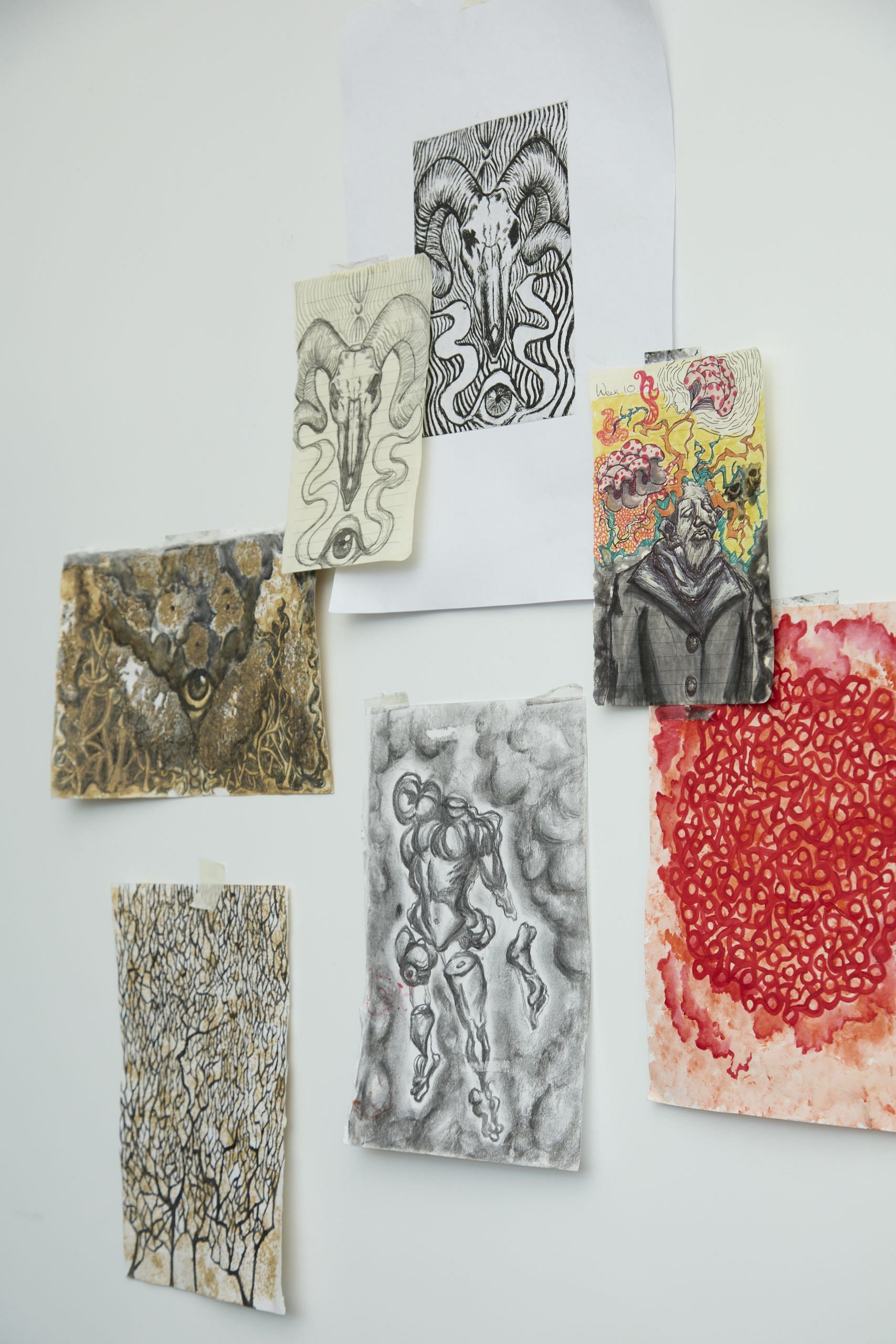
What were you before this?
“I have a Diploma in Nursing from Nanyang Polytechnic and worked full-time as a nurse for three years before deciding to switch fields. I don’t have a formal arts background prior to enrolling in NAFA.”
What are the most common responses you get when you tell others that you study fine arts?
“People usually ask what career in the arts I would pursue; if I can make money from the arts; or if I’d go back to nursing… I find this line of questioning rather repetitive so such conversations usually do not last long. The stereotype of the starving artist remains, especially among the older generation, but I have no energy to entertain that.”
Biggest misconception about fine arts students?
“That art students just go to school to draw. The reality is far from that. It is no longer about perfecting a certain painting technique or becoming the next Michelangelo. There are so many things that are taught: the developing of artistic concepts; individual research and practices; collaborating with non-art fields such as healthcare; using art as a tool for advocacy; ethics and morales, and so much more.”
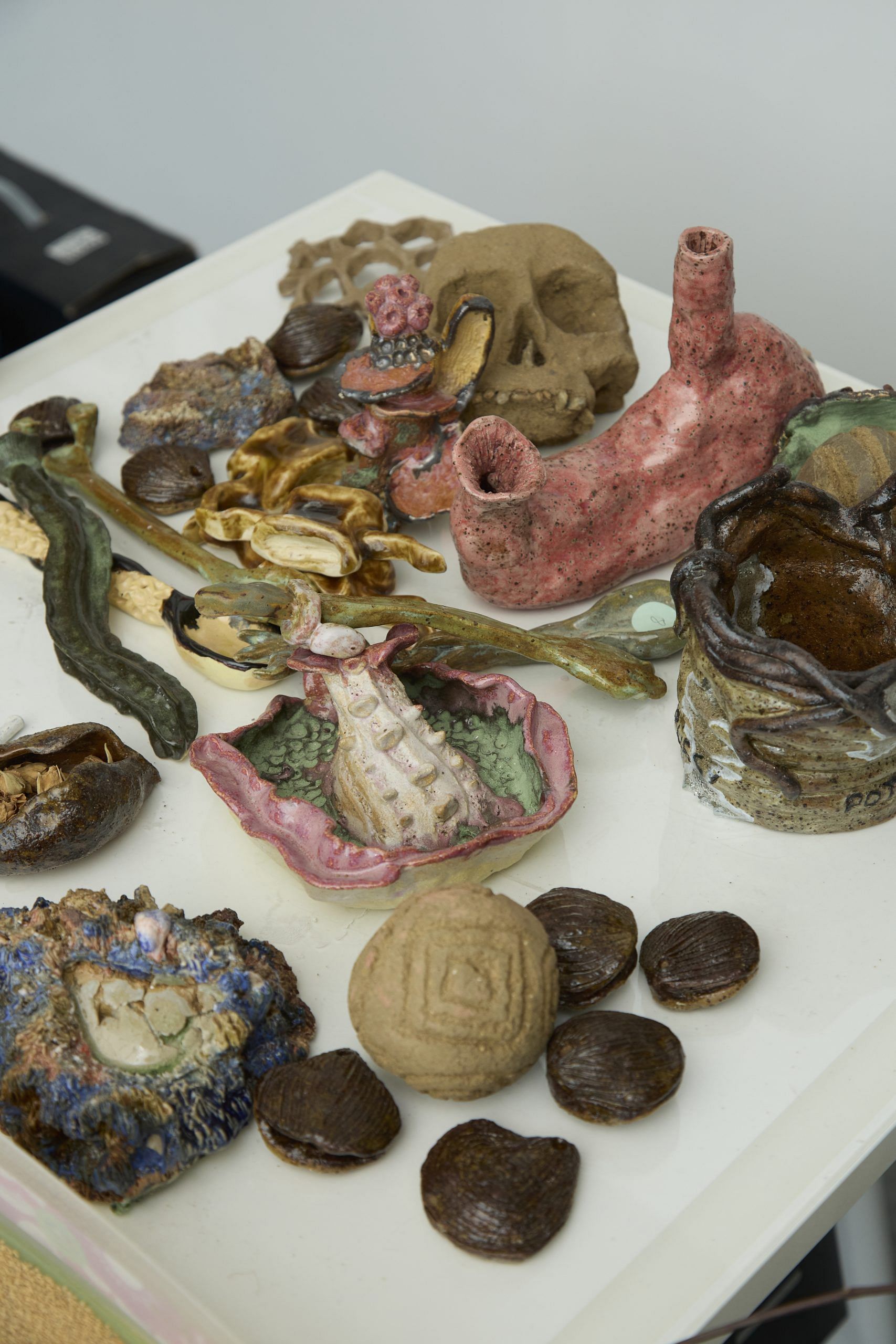
What is the toughest thing about your current academic programme?
“Initially, it was finding my own identity and art style independently with my limited knowledge in the arts. Here we are allowed to explore anything and everything, and that was overwhelming at first. However once I reflected on what I am truly interested in communicating, I could streamline my interests and practice.”
And what do you love most about it?
“The classmates and the lecturers. They have been supportive and inspiring, and created a safe space for everybody to explore their own art practices. I have had so many good memories thanks to them. They’ve also helped shape my own individual practice through their feedback.”
What would you have studied if you weren’t studying fine arts, and why?
“I can’t choose one so let me list them all: marine biology, forensic anthropology, archaeology, palaeontology or veterinarian science. I am intrigued by the functions and pathophysiology of living things as can be seen in some of my works, but I cannot do maths, so I do art.”
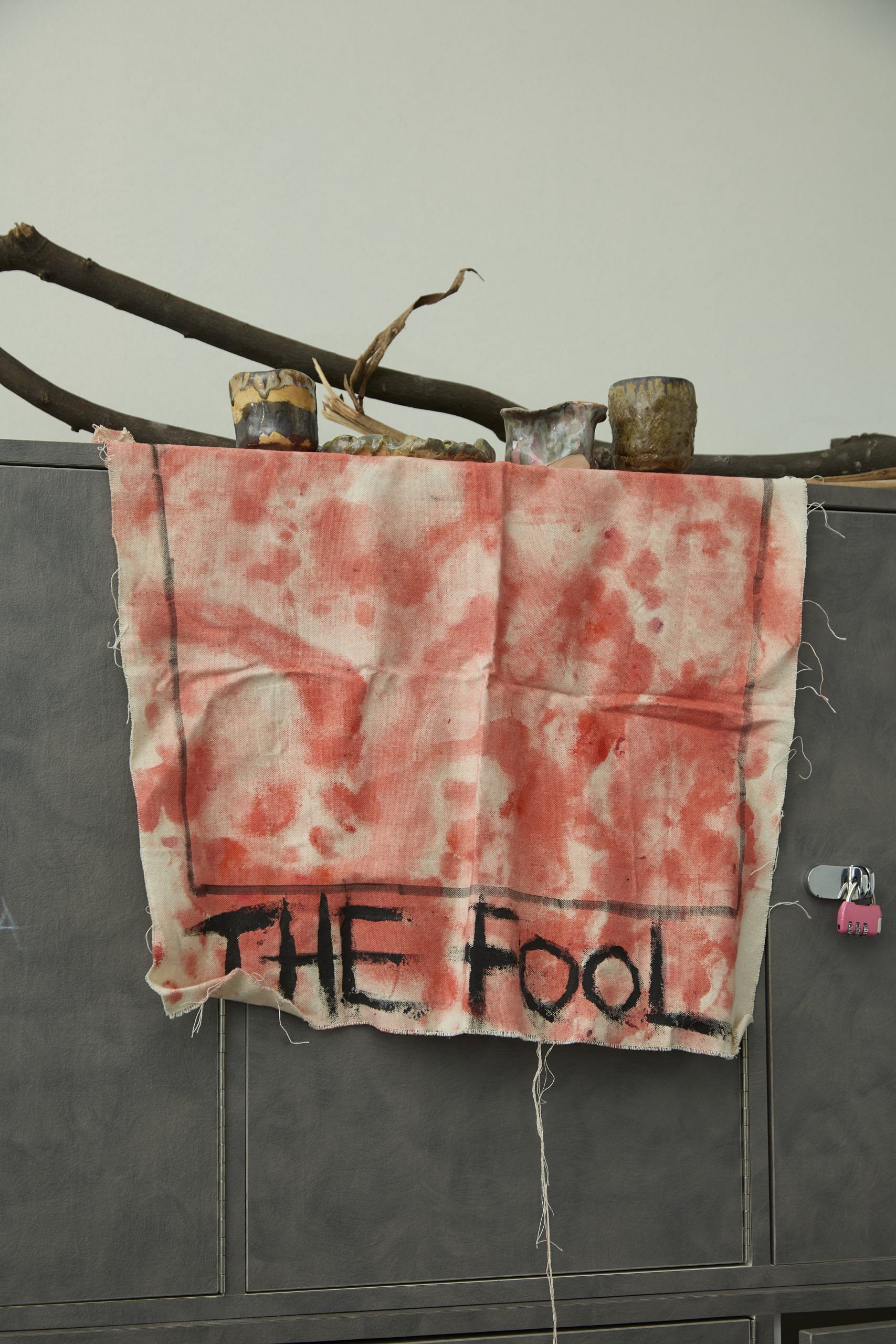
What do you hope to achieve with your fine arts degree?
“Holistically, a better understanding of myself and my art practice. And a job.”
What do you hope to do after graduation?
“I am exploring various fields such as art curation, teaching, and community art. I am also interested in medical illustration because it combines both my interests in biology and art.”
How do you feel about the art scene in Singapore and how does this impact you as a fine arts student?
“Most of my interactions within the art scene have been pleasant. Artists in Singapore are supportive, giving feedback and advice as well as helping young artists make connections within the art community. The art scene is also very rich in culture. You can see many themes being explored in the art scene, such as mental health advocacy, queer stories, culture and heritage, the spiritual realm, and both Asian and western art. I feel very motivated because I feel supported and that I am not alone in the journey to become an artist. Having such a diverse art scene constantly exposes me to new knowledge and stories, which I find both educational and entertaining.”
What do you think is needed to allow you to grow as a fine arts student?
“More funding for external projects initiated by fine art students.”
ELISA TAN, 19, YEAR ONE STUDENT IN LASALLE COLLEGE OF THE ARTS’ DIPLOMA IN FINE ARTS PROGRAMME

Tell us more about your interest in art: When did it start and how was it fostered?
“I think everyone did art as kids, and I wasn’t any better than my peers nor did I like drawing better than others. However I got into photography on a whim and found it to be a medium that I resonated with strongly. I continued to shoot and was lucky to be selected for a mentorship programme under the Objectifs Centre for Photography and Film and participated in the Angkor Photo Festival and Workshops. Meeting so many artists and creatives through this process kindled my joy for creation.”
What made you decide to pursue fine arts academically?
“I knew I wasn’t going to be happy in a normal collegiate programme. I wanted to find a community of artists to immerse myself in so that we could better ourselves and each other. Art school seemed to be the simplest solution. I also wanted to solidify my foundational skills since I have never undergone formal art training till now.”
What school were you in before this and did you also study art then?
“I was in the Singapore Sports School doing fencing, not art!”

Tell us more about what led you to your chosen art medium?
“Loosely, lens-based art encompasses any art that is made with a camera. To be honest, I first got into photography because I wanted to impress an ex-boyfriend. It’s a bit embarrassing now to admit it because it betrays my feminist beliefs, but it is what it is. I realised that photography could be so much more than just a means for visual aesthetics. And I was lucky to have met mentors and peers who guided me to further develop my artistic practice.”
Describe your practice and intention as an artist
“I like using satire to talk about the relationship between politics and my personal experiences. I deeply believe an artwork should tell the viewer something about its artist and this informs how I produce images.”
Are your parents and loved ones supportive of your choice to study fine arts, and does this matter to you?
“My family and loved ones have been tolerant, if not supportive of my art. I do get some raised eyebrows with my tattoos and questionable fashion sense, or I might come home with weird things I picked up off the side of the road, but everyone in my life has been at least indifferent to my pursuits. I’m glad that no one actively tells me that art is a waste of time, and I’m very grateful for this loving and supportive community.”
What are the most common responses you get when you tell others that you study fine arts?
“People tend to ask me what I do in school, and I get a vague sense that they view fine arts as this mysterious, elusive, and exclusionary concept reserved for a select group. I get it – historically, art has been an endeavour gate-kept by the rich and elite. Although the barriers to entry have lowered remarkably since, it’s difficult to convince some people that everyone can be an artist so I don’t try to correct them. I do feel a bit sad, but what can one do? They’re not entirely wrong; just slightly dated in their opinions.”
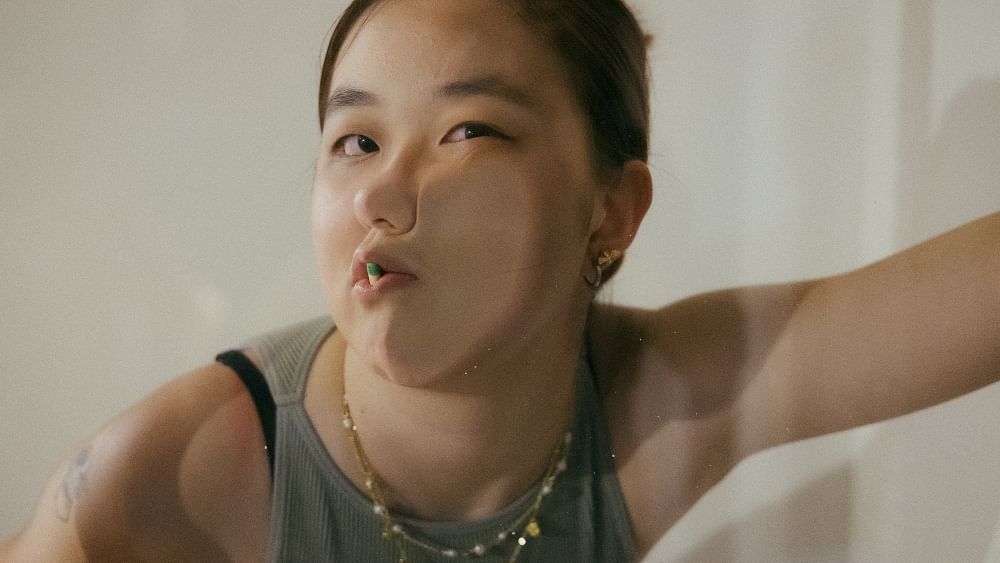
Biggest misconception about fine arts students?
“That we have unattainable, lofty goals that have no real basis in reality – like painting in the French countryside for years with no sponsor and still somehow managing to make a living. Most of us recognise the reality of being an artist today, especially in a highly commercial and cosmopolitan city like Singapore: that it is difficult to make money to survive off fine art alone and that we will have to do commercial jobs to make a living. For example, I’ve done a wedding photography internship, and have helped out with interior design photography to better understand the workings of the commercial world. My peers are similarly aware that it’s unlikely we can get by creating whatever we want. Our lecturers also frequently tell us about their own real-world experiences vis-a-vis commercial or commissioned work. We’re not delusional. In fact we’re quite aware of our future career paths.”
What’s the toughest thing about your current academic programme?
“As cliche as this might sound, it’s being able to stay disciplined. Our curriculum is largely self-driven and much work is done outside of class. It’s hard to blame anyone except myself for last-minute all-nighters during submission week.
And what do you love most about your programme?
“I love that everyone is a constant source of inspiration. Walking around the studio space, I see all the works in progress and after setting aside my imposter syndrome, I feel refreshed and revitalised because I am being surrounded by our future artists – and I could be one of them! When I talk to my peers about our works and we bounce ideas off of each other, I am reminded of how our differences are breeding grounds for inspiration. And it doesn’t hurt that so many of my classmates dress well. It’s frankly very fun.”
What would you have studied if you weren’t studying fine arts, and why?
“I would have studied political science, philosophy, and economics (PPE). It was my long-term dream to work with the Ministry of Foreign Affairs or the United Nations, but it seems that my calling has led me elsewhere.”
What do you hope to achieve with your fine arts degree diploma?
“In terms of academic or career progression, I hope to continue school and get a degree in fine art before working with local galleries, festivals or businesses to produce images. In terms of personal goals, I want to use the resources made available to me to experiment as much as I can with various mediums and processes. School is the best place to make mistakes and mess around, so I hope to use my three years here in Lasalle to try as many things as possible.”

What do you hope to do after graduation?
“If I have the money, I’d probably go overseas to find inspiration and connect with artists. If I can’t afford this, which is highly likely, I would like to open a small specialty coffee shop and do tattoos for people. I am aware that this is overly idealistic, but I live in a fantasy world of delusion. Jokes aside, I might try to get a job at an arts space.”
How do you feel about the art scene in Singapore and how does this impact you as a fine arts student?
“I think the art scene in Singapore is still young and that there’s a lot of room for us to explore our personal styles and themes. Compared to countries with a longer history, our sense of national identity is not particularly developed. As a result, there seems to be a lack of cohesive, identifiable traits among Singapore artists. Having this relatively new art scene has the benefit of opportunity: You can make it big even if you’re a newcomer. It’s also nice that Singapore is such a small country – people in the art scene all know each other and know who to talk to for whatever purposes, which helps to build a close-knit community. It feels encouraging to have an environment for creatives to actualise their visions while being surrounded by similar-minded artists who want to better each other and themselves.”
What do you think is needed to allow you to grow more as a fine arts student?
“I’d love to have more opportunities to submit to open calls. Beyond just what’s graded in school, which is based on a rubric, I would like to better understand what would be accepted into galleries and shows. Funding to have overseas exchanges with art spaces would be great too.”
QALISHA FARIQ, 20, YEAR ONE STUDENT IN LASALLE COLLEGE OF THE ARTS’ BA (HONS) FINE ARTS PROGRAMME

Tell us more about your interest in art: When did it start and how was it fostered?
“Since I was a child, I’ve had a love for drawing and painting as well as tiny knick knacks and trinkets. Art has always provided a safe space for me to relax and unwind, and I used to seek comfort in art whenever I felt like running away from reality. However, growing up, I became more of a realist and wanted to land a stable job and turned my artistic interests into a hobby. I do have an interest in science and initially wanted to venture into psychology or medicine.”
So what made you decide to pursue fine arts academically?
“I got Covid-19 just a couple of days before my A-Levels and didn’t sit for the majority of the papers, resulting in marks that couldn’t get me into the courses that I wanted. While waiting for my college application results, I sat down with my aunt one day and told her I wasn’t even sure anymore if I wanted to pursue a degree – at that time, I was starting to feel burnt out and didn’t see any meaning in continuing my studies… In response, she told me to simply choose a degree course that I believed in. This made me wonder why I had not considered a degree related to the arts, which has always felt like second nature to me. I realised I had missed the application date for such programmes so I decided to take a gap year to make art with the intention to heal as well as to come up with a portfolio for the next round of applications.”
Are your parents and loved ones supportive of your choice to study fine arts, and does this matter to you?
“It was an unexpected move because I’ve never outwardly shown any interest in wanting to pursue the arts, but my family has always been supportive of my choices and for that I’m grateful.”
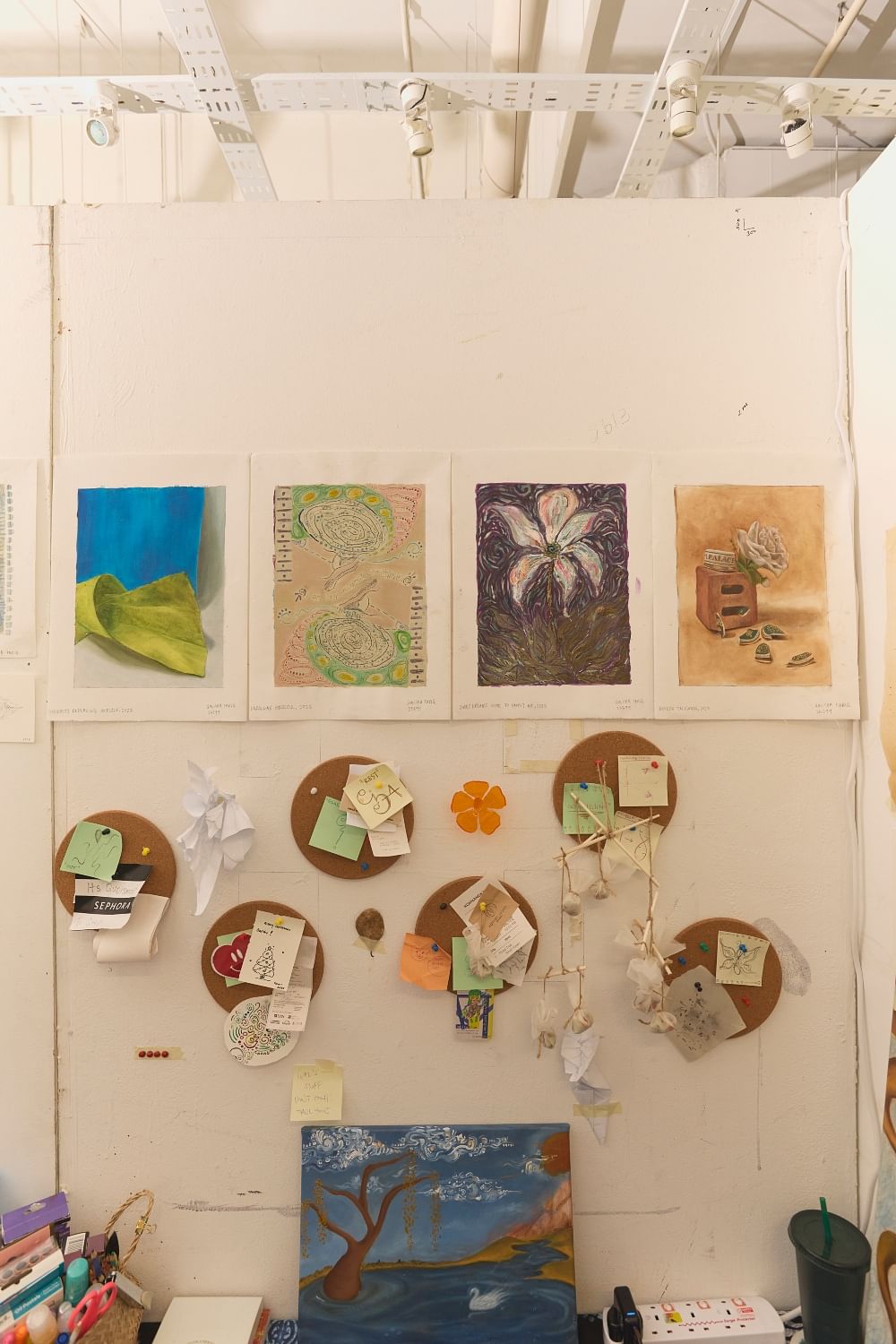
Biggest misconception about fine arts students?
“That our work is easy and that it doesn’t require much thinking or effort, which is absolutely false.”
What’s the toughest thing about your current academic programme?
“Sometimes I have an idea or expectations about how I’d like my work to turn out, but with our deadlines, it’s hard to achieve them.”
And what do you love most about it?
“I love the people and the space.”
What would you have studied if you weren’t studying fine arts?
“I would have studied psychology because of my interest in the human mind and condition.”
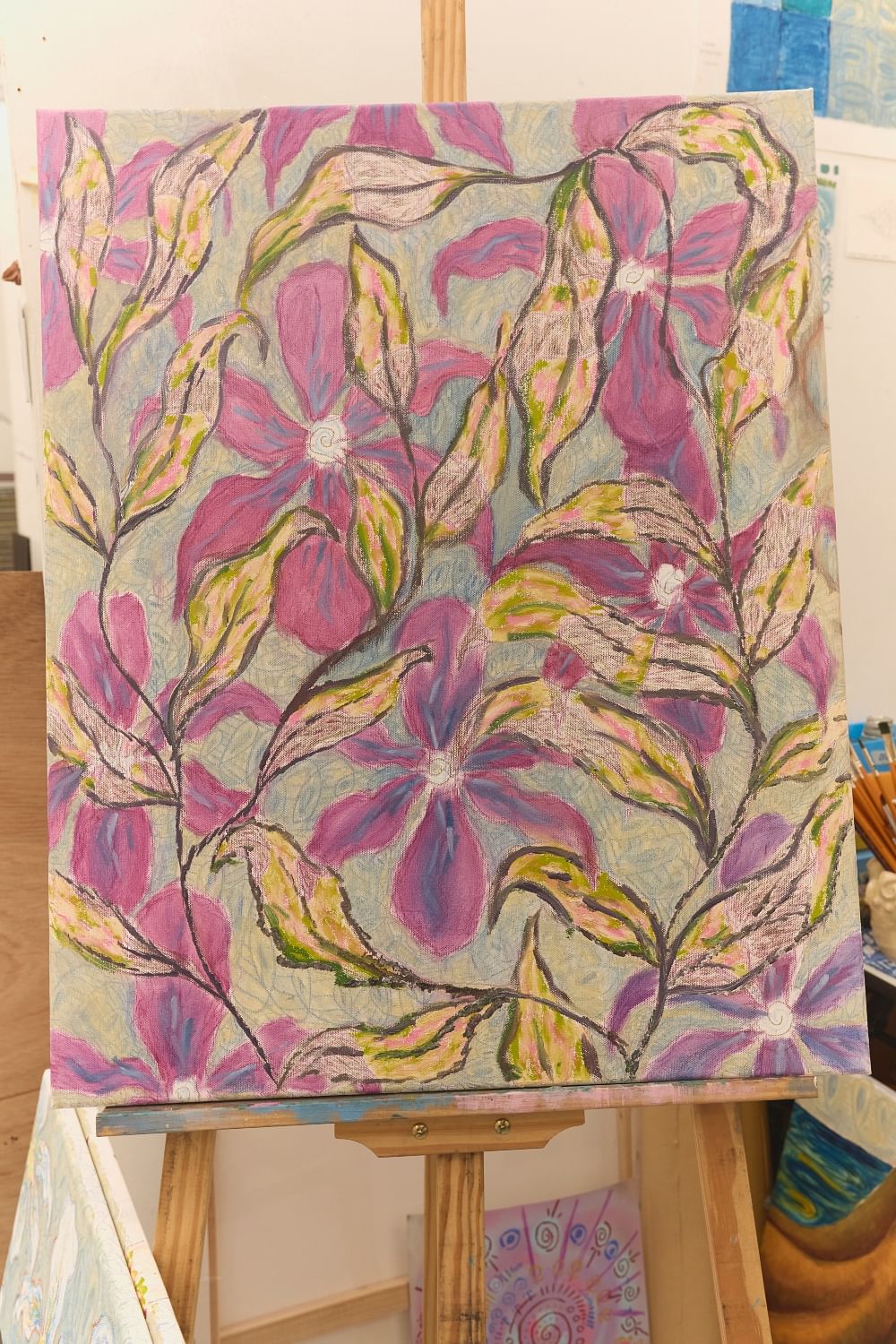
What do you hope to achieve with your fine arts degree?
“I hope to gain enough experience to be able to practise on my own and to be better equipped to carry out my intentions as an artist in the real world.”
What do you hope to do after graduation?
“I hope to do residencies both here in Singapore as well as overseas… I also like the idea of opening up an art studio where people can come to see artists at work and attend workshops.”
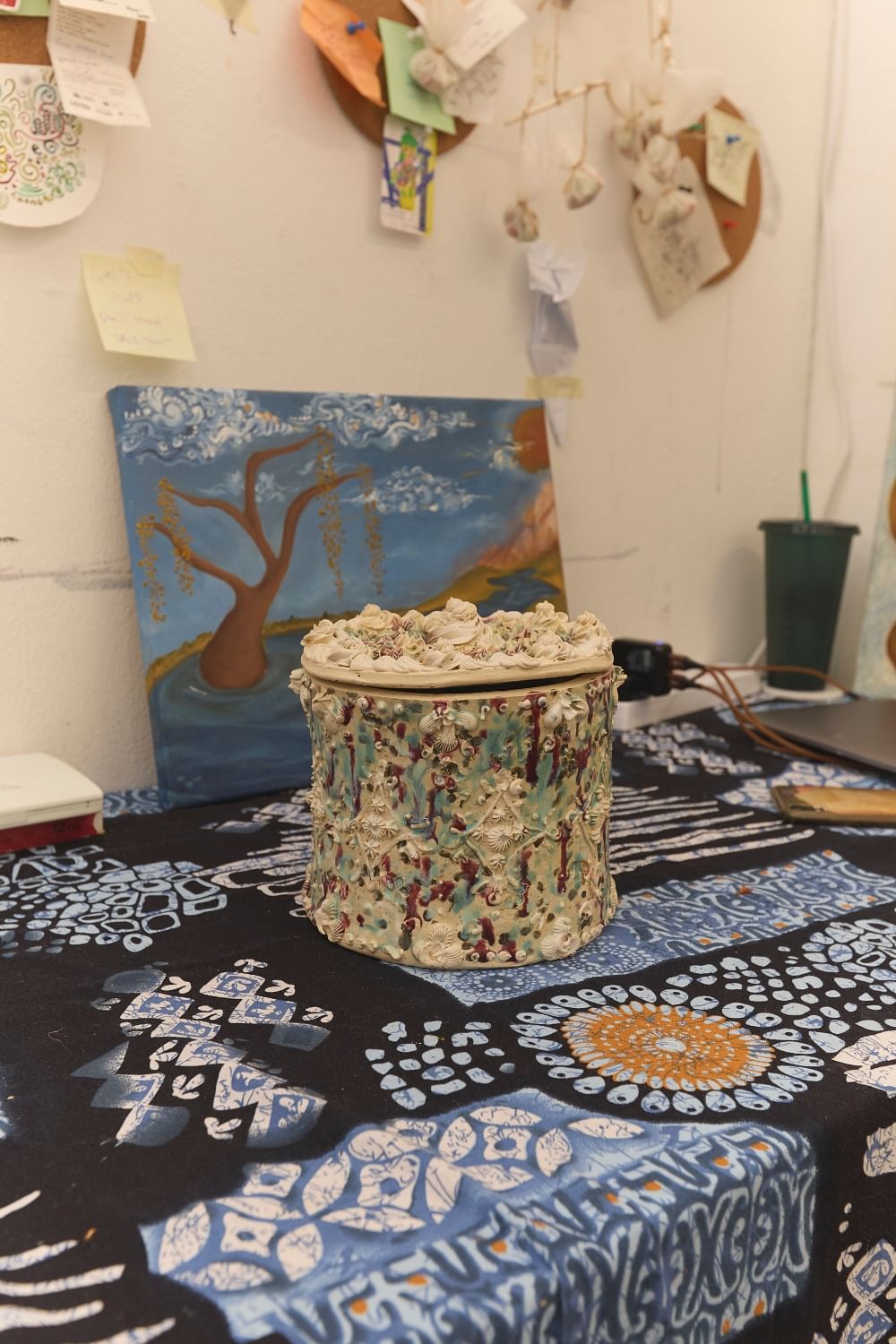
How do you feel about the art scene in Singapore and how does this impact you as a fine arts student?
“While the industry is trying to be more inclusive, there is still a sense of exclusiveness and opportunities are not widely open to every artist or art style, especially those that are more experimental. This can make it discouraging for those who want to pursue the arts as an academic discipline or profession, but I am hopeful for change that will come with the next generation of artists.”
Text & Art Direction Keng Yang Shuen Portrait Photography Athirah Annissa Coordination Pang Jiawei
All interviews have been edited for clarity and brevity.












